Electrical Apparatus
More than Motors
Annual Energy Issue
Ill winds could bode well for one renewables industry

Spying on polluters
History of motor efficiency
Mid-year employee reviews Alternative vehicle fuels
Post-closing M&A disputes
A BARKS PUBLICATION APRIL 2024 / $10



















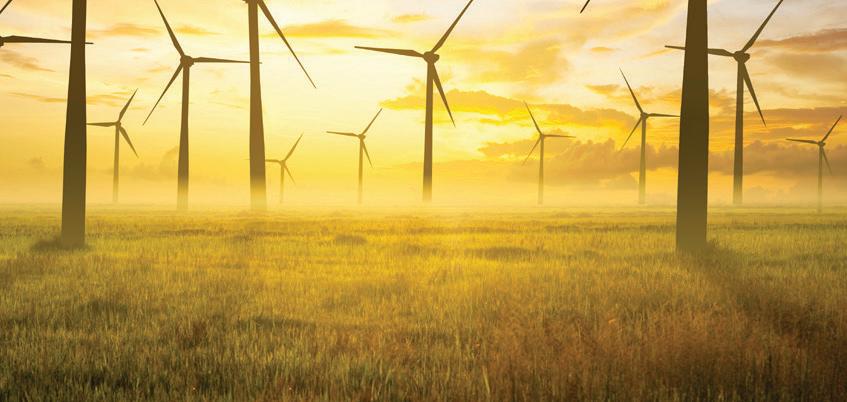






Electrical Manager
10 The mid-year review
Understanding the benefits for both the underperformer and the overachiever
By Bill O’Leary, EA
Contributing Writer
Electric Avenue
18 Going beyond EVs
In light of the shortcomings of electric vehicles, alternative fuel sources are being considered
By Maura Keller, EA
EA Reader Profile
Contributing Writer
22 The hand of providence
For Rodney Fuller, good things have a way of following hard work
By Colin Gregory-Moores, EA
Contributing Writer



Energy
27 Ill blows the wind
The wind industry is weathering storms — financial, engineering, and geographic — that in the end will likely make the industry stronger
By Bill O’Leary, EA Contributing Writer
42 Eye in the sky
A satellite is intended to monitor and ‘call out’ the world’s worst polluters
By Charlie Barks, EA
Managing Editor
Motors & Generators
33 The road to improved motor efficiency
A brief look at the history and current status of the U.S. Dept. of Energy’s motor efficiency regulations
By John Malinowski, EA Contributing Editor
Finance
37 Post-closing M&A disputes
The best way to deal with conflicts between business buyer and seller is by preventing conflicts in the first place
By William H. Wiersema, CPA, EA Contributing Editor
Training & Education
43 Embracing rotational training
A pattern of promotion that can help an individual gain a ‘big picture’ understanding of a business
By Maura Keller, EA
Contributing Writer
Pump It Up
44 Feds open the money spigot for water infrastructure spending
An unprecedented quantity of money is being unleashed for spending on U.S. water infrastructure — but there’s a catch
By Kevin Jones, EA Senior
Editor
22
A BARKS PUBLICATION VOLUME 77 / NUMBER 04 WWW.BARKS.COM 04/24 — Tennessee Aquarium photo —
Energy Corp. photo — Adobe generative AI image ELECTRICAL APPARATUS | APRIL 2024 1
27 33 Contents
Duke



04 The editor’s comment Energy in limbo 06 Speaking of . . . Clean power company Exro Technologies expands again 07 Let’s solve your problem Questions and answers about electric motor efficiency 08 Associations Associations point the way toward AI in machine maintenance 14 Know your industry Edison Electric Institute is not your average institute 16 Calendar Events on electrical maintenance and facility management 25 Business Recent mergers and acquisitions
Say it right Making technical writing less verbose 39 Names & faces Personnel changes at Helwig, Origami Solar, and NAED 40 Product showcase What’s new in tools, clean energy, and fire protection 46 Utilities New handbook explains U.S. wholesale energy markets 47 Plant happenings Plants in Tennessee, Pennsylvania, and Alabama to expand 48 Classified advertising Your monthly marketplace for equipment, businesses, and more COVER PHOTO: By Natascha Kaukorat / Shutterstock. An offshore wind installation under construction. 25 26 40 Departments 48 Cy’s Super Service The electrical service industry’s most prominent curmudgeon 49 EA puzzle A word search puzzle based on this month’s “EA reader profile” 51 Moe, Genny & friends The surreal world of an anthropomorphized motor and generator 52 Direct & current Schneider fends off a hacking attempt, and Apple ditches an EV 52 Advertising index Who’s who—and who’s where—in this issue of Electrical Apparatus — Precision Coil and Rotor photo — Illustration by Bing generative AI — Mill Industries photo 2 ELECTRICAL APPARATUS | APRIL 2024
26










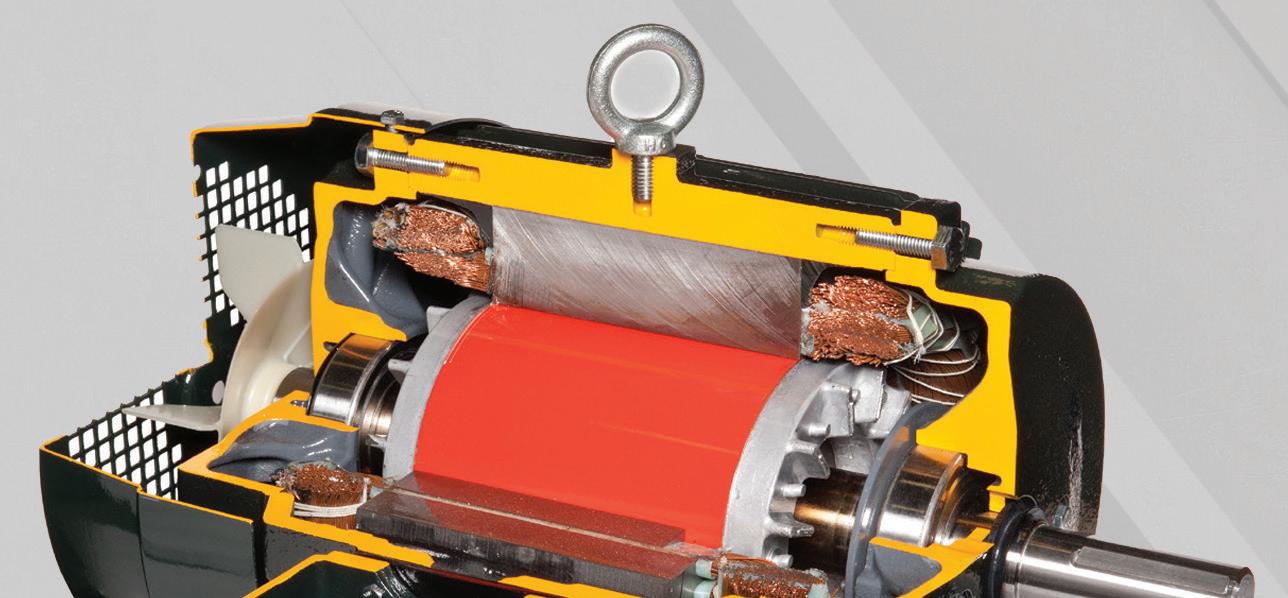


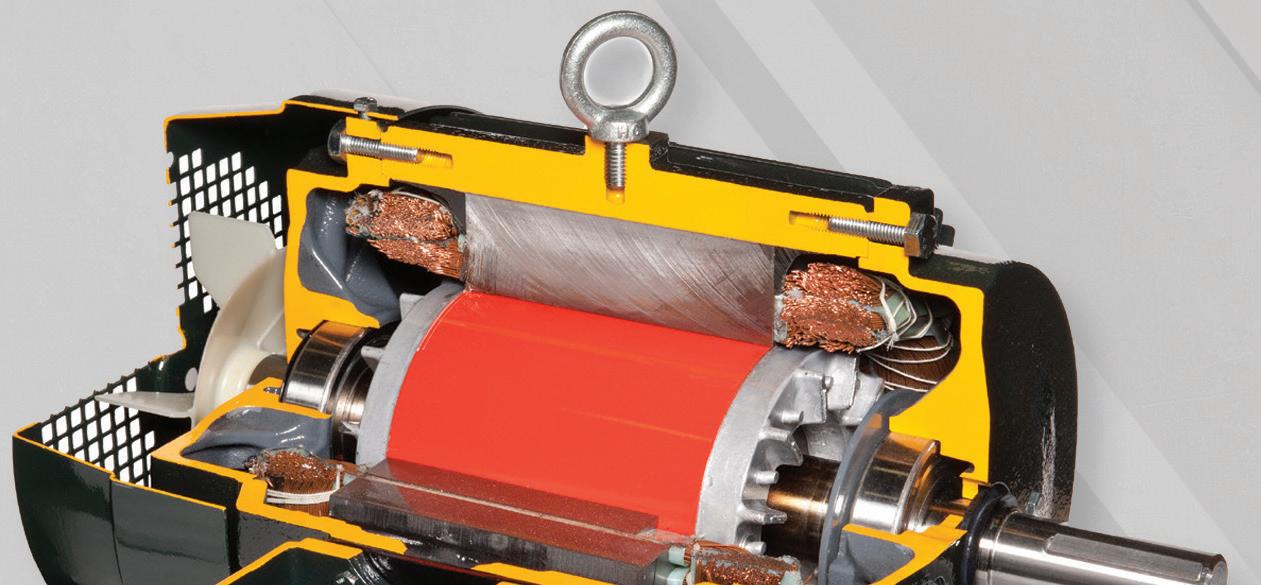











Quality
BEARINGS
VIBRATION
DUTY CONSTRUCTION •100% QUALITY TEST •INSULATION WITH WIDE THERMAL CAPABILITY
INTER-LAMINATION MATERIAL •HIGH TORQUE OUTPUT
QUALITY CONSTRUCTION WWW.TOSHIBA.COM/TIC (US) 1-800-231-1412 EQP Global SD, 840, 841 Low Voltage Motors Performance and
•OVERSIZED
•LOW
•HEAVY
•C5-RATED
•HIGH
The Editor’s Comment

Coming next month in Electrical Apparatus:
EASA Convention venue preview; adjustable-speed drives in industrial systems; the economics of direct labor and inventory; UL’s “healthy building” designation
Read Electrical Apparatus online
The entire contents of this issue are available online. Scan the QR code below:
Energy in limbo
The highly impactful energy sector has never been more in uential. In some ways, it’s never been more lucrative. Its popularity and visibility have increased — energy is talked about more in the news than ever before due to climate implications and the surrounding debate.
However, despite progress being constantly touted in areas such as renewables, the world of energy could also be looked at as being at a standstill. Things appear to get done, such as progress on emissions reduction and decarbonization, only to witness oil and gas companies record one of their best years ever in 2023 in terms of production. Energy in 2023 appears to be in the midst of a game of tug-o-war.
In this issue, we’ll take a look at what that means for those of you on the ground, in terms of OEMs and repair services, HVACR companies, and anyone energy-adjacent. In particular, our cover story by EA Contributing Writer Bill O’Leary (“Ill blows the wind,” page 27) focuses on the advancements and pitfalls of the wind power industry, one of the methods at the forefront of the renewables movement. One expert, Douglas Hines, president and CEO of O shore Wind Power Systems of Texas LLC in Grapevine, Tex. — who describes his experience as having come on “both sides of the ght” — sums up the challenges this way: “There has been a great deal of in ghting between renewable communities and the oil and gas companies too, as each has staked their own rights in the marketplace. Technically you have the experience on the O&G side and the political and capital support with the renewable group, and they are still ghting.”
On the regulatory side of things, the jockeying continues, as nonpro ts begin to assert more force in their e orts to monitor emissions and detect corruption.
For example, in early March, a controversial satellite labeled “MethaneSAT” lifted o with intentions some consider righteous but many others are calling dubious. The satellite’s stated design mission is “to help protect the Earth’s climate by accelerating reductions of a powerful greenhouse pollutant, focusing rst on oil and gas operators, the world’s largest industrial source of methane emissions,” according to its developers. Yikes. Oil and gas operators have long been a target of climate activists’ ire, but never before have they had to consider an all-seeing eye in the sky watching everything they do with the intention of relaying it to the public. You can read all about it in “Eye in the sky,” page 42.
Electrical Apparatus
17 N. State St., Suite 435 Chicago, Illinois 60602-3598
(312)321-9440; fax (866) 228-7274
E-mail: EAMagazine@barks.com
www.barks.com
Founded 1948 as Volt/Age
Horace B. Barks, Founding Publisher
Elsie Dickson, Founding Publisher
STAFF
Elizabeth Van Ness, Publisher
Kevin N. Jones, Senior Editor
Richard L. Nailen, Engineering Editor
Charlie Barks, Managing Editor
Contributing Editors
William H. Wiersema
John Malinowski
Special Correspondents
Jane Powell Campbell
Christopher Wachter
Cartoonists
John D’Acunto
Tim Oliphant
ElectroMechanical Bench Reference
Supplement mailed with the December issue
Elizabeth Van Ness, Editor & Publisher
ADVERTISING
Barbara Wachter, Advertising Director
CIRCULATION
Circulation@barks.com
Electrical Apparatus (ISSN 0190-1370), Vol. 77, No. 4, is published monthly by Barks Publications, Inc., 17 N. State St., Chicago, Ill. 60602; (312) 321-9440; fax (866) 2287274. www.barks.com. Periodicals postage paid at Chicago, Ill., and at additional mailing o ces. Postmaster: Send address changes to Electrical Apparatus, c/o Barks Publications, Inc., 17 N. State St., Suite 435, Chicago, Ill. 60602. PM #40830553
U.S. subscriptions: 2 years—$100; 1 year— $60. Foreign airmail: 2 years—$250; 1 year—$140. Subscriptions also include an annual directory supplement, the ElectroMechanical Bench Reference. Single copies: $11 each plus postage; December issue, $30 with the supplement ElectroMechanical Bench Reference.
Copyright 2024 Barks Publications, Inc.
Reproduction of any part, by any means, including photocopy machines and computer networks, without the written permission of Barks Publications, Inc., is prohibited. Electrical Apparatus and ElectroMechanical Bench Reference are trademarks registered with the U.S. Patent O ce.
Or enter the URL directly:
https://bit.ly/ APR24WIND
See page 50 for links to upcoming issues that you can bookmark.

Copies of articles in print or PDF format may be ordered from our Marketing Department (312)321-9440. Prices available on request. Libraries and companies registered with Copyright Clearance Center, 222 Rosewood Dr., Danvers, Mass. 01923, should send 75¢ per page copied direct to CCC.
Material also available in microform and CD-ROM from Pro Quest information service, (800) 521-0600 ext. 2888 (US) or 01734-761-4700 (International); https://www. proquest.com/.
Printed in the U.S.A.
CHARLIE BARKS WWW.BARKS.COM CHARLIE@BARKS.COM
4 ELECTRICAL APPARATUS | APRIL 2024





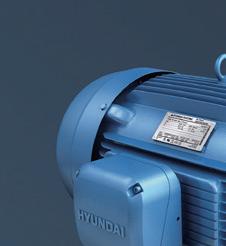








D-flange
C-face
D-flange










































































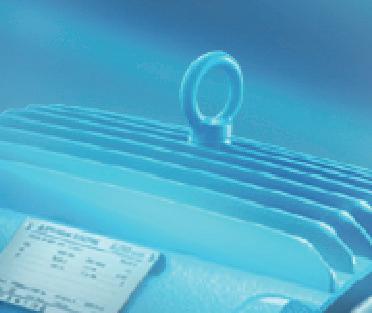


































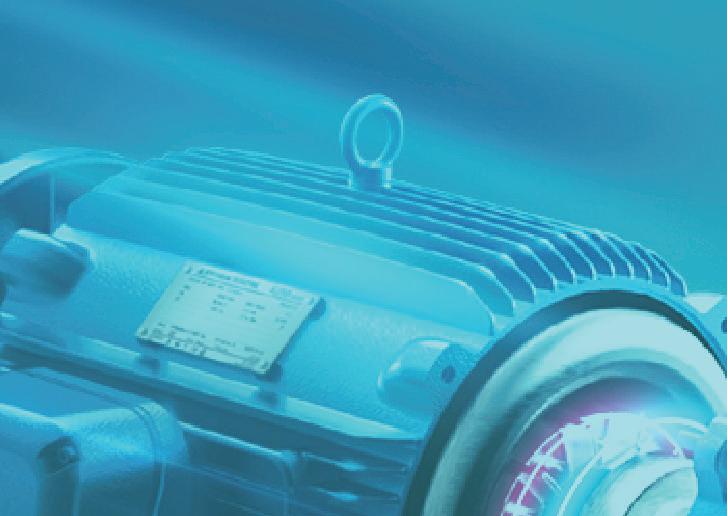

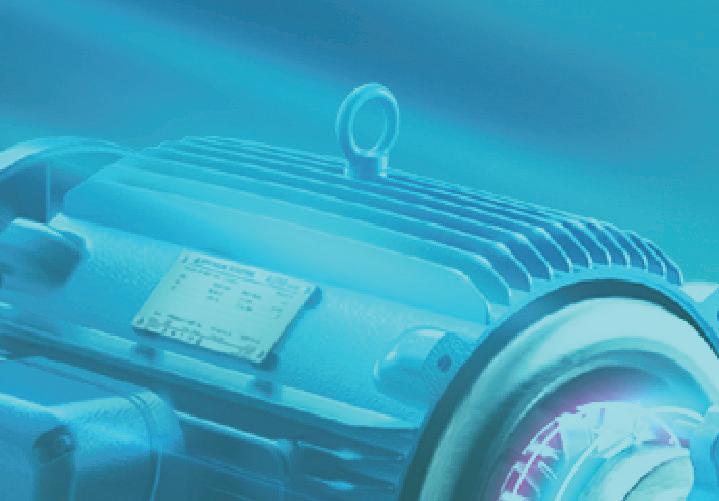























































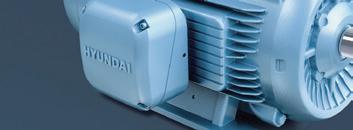





Official website Certified Class I Division 2 IEEE841 Premium Efficiency TEFC 3Ph, AC Motors 1HP~900HP VFD Rated - NEMA MG1 Part 31 · · · · · Severe Duty and IEEE841 Motors ■ C-Face and Flange Mount Motors ■ Please contact here ■ +1-678-789-1885 LVmotor@heamerica.com HYUNDAI Always ready State of the Art Modern Manufacturing facilities · · Cutting Edge Design Engineering Explosion Proof Motors ■ IEC Metric Motors ■ Certified Class I Division 1
proof Premium Efficiency
3Ph, AC Motors 1HP~250HP VFD Rated - NEMA MG1 Part 31 · · · · · · Cast Iron Construction Certified Class I Division 2 Premium Efficiency
3Ph, AC Motors 1HP~250HP VFD Rated - NEMA MG1 Part 31 · · · · · Foot mounting
with Foot mounting
Explosion
TEFC
TEFC
C-face
with Foot mounting
without Foot mounting
without Foot mounting · · · HYUNDAI Always with you Large Inventory supplied by multiple warehouses · World Class Quality, Performance and Reliability ·
Speaking of . . .
Exro expands again
Calgary manufacturer Exro Technologies and California EV company SEA Electric, Inc., announced Feb. 16 that they have entered into an agreement providing for the acquisition of SEA by Exro.
This business combination is expected to strengthen Exro’s technology o erings while accelerating revenue growth and Exro’s path to pro tability. Following completion of the transaction, the combined company will continue to operate under the name Exro Technologies, Inc., and trade on the Toronto Stock Exchange (the “TSX”) under the ticker symbol EXRO.

“We are pleased to announce the merger between Exro and SEA Electric, which unites our complementary EV technology platforms and unlocks substantial opportunities for growth and a path to pro tability. Our merger with SEA not only creates signi cant revenue and cost synergies but positions Exro to amplify its growth with new partners while continuing to develop our existing relationships,” said Sue Ozdemir, CEO of Exro.
“Having come to know SEA and its management team from doing business with them over the past several
years,” Ozdemir went on to say, “I have great con dence that this acquisition will bolster our competitive positioning in the EV technology space while providing signi cant value potential for our shareholders.”
In related developments for the clean technology company, which hangs its hat on “new generation power electronics,” Exro also announced the closing of a previously announced private placement o ering of subscription receipts. Pursuant to the o ering, Exro issued a total of 31,600,000 subscription receipts at an o ering price of $0.95 per receipt for total gross proceeds of approximately $30 million.
Exro and SEA have both been featured in the pages of Electrical Apparatus multiple times over the past few years since their separate foundings in 2014. — Charlie Barks EA
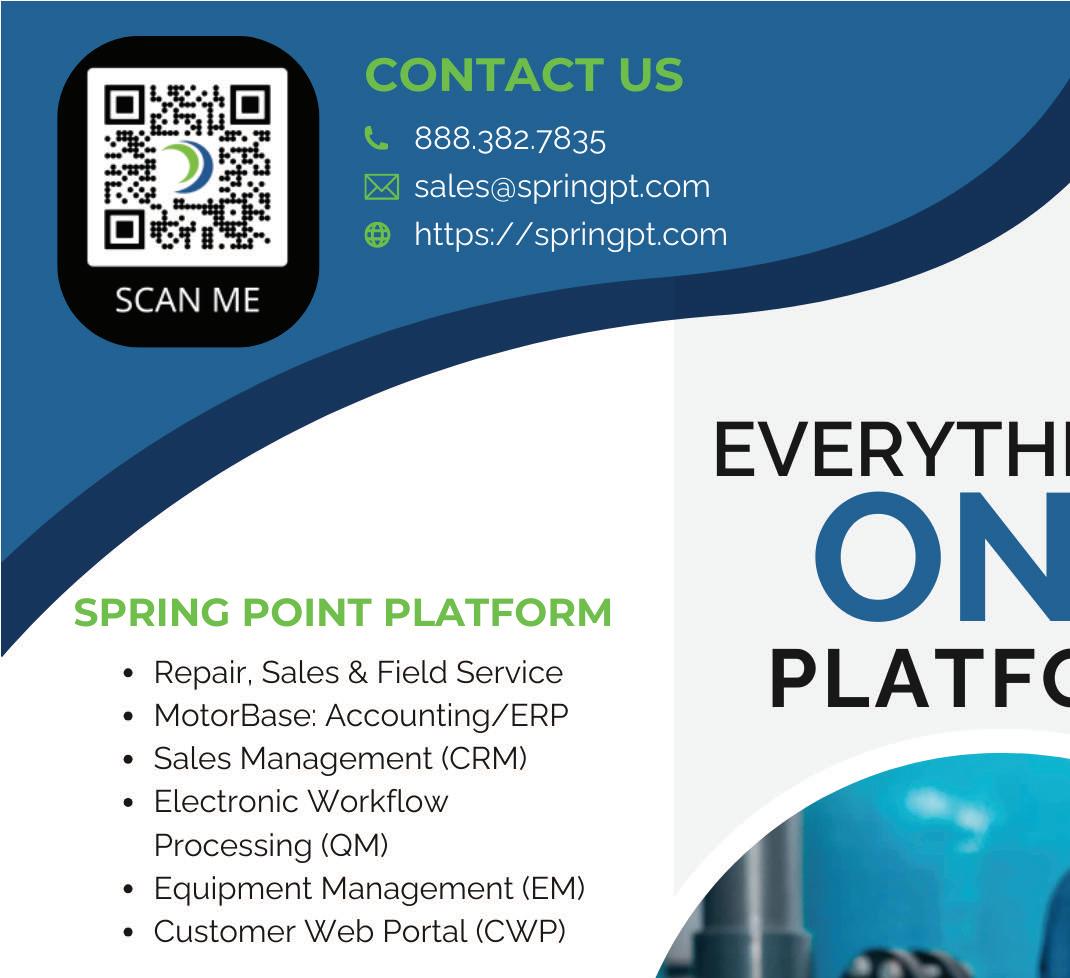


 The Exro Technologies U.S. headquarters in Mesa, Ariz.
The Exro Technologies U.S. headquarters in Mesa, Ariz.
6 ELECTRICAL APPARATUS | APRIL 2024
— Exro photo
Some e ciency motor claims di cult to verify
In dealing with commercial refrigeration equipment, we are always looking for chances to promote energy e ciency if it can be done cost-e ectively.
Now we’re seeing claims that premium motors in this equipment can be several times more e cient than ordinary motors. What does this really mean? How can savings be gured?
Phrases such as “twice as e cient” are meaningless.
Inasmuch as e ciency of these small commercial motors is typically below 50%, “twice” the e ciency ought to mean 100%, which of course is impossible.
We expect that what is meant is that losses in the newer design motor are half the losses of the other version. This may be possible, but it’s not what the claim says. And available test procedures make it di cult to verify.
Newer HVACR systems are using variablespeed compressors that can lead to energy savings of 30% or more over a xed speed system.
Additionally, Dept. of Energy regulations on HVACR motors have mandated higher system e ciencies over older machinery.
E ciency can go by many names
The terms nominal and minimum for motor e ciency are de ned by NEMA and are used in the Energy Policy Act. What has bothered me is the use of various other names for motor e ciency applied to ratings that the law and the standards don’t cover — for example, a 600 hp motor. Terms like “design e ciency” and “calculated e ciency” are sometimes used. How should we interpret these terms?
Motor manufacturers show a nominal efciency value for the motor based on rated horsepower and load at nameplate voltage and frequency as required by NEMA and the U.S. Dept. of Energy. NEMA de nes e ciency levels in MG 1, Part 12. Most three-phase motors today comply with Table 12-12 showing nominal e ciency values for Premium Eciency motors.
These are the same levels used by the Dept. of Energy as well as by regulatory agencies in Canada and Mexico. Imported motors also must comply with these levels. Table 12-10 shows the minimum e ciency for each eciency level. NEMA MG 1, “Standards for Motors and Generators,” is available as a free download at www.NEMA.org.

Motor Tester & Winding Analyzer
Electrom Instruments is proud to introduce the new iTIG IV Series motor tester and winding analyzer. Smaller, faster, and lighter than ever! Now with faster automatic testing and a lightweight construction, the iTIG IV offers accurate and reliable testing in a rugged and compact case. See

Should motor e ciency ever be above average?
In costing out motor purchases, we have a problem interpreting nominal e ciency. After calling for some tests to verify the claims of suppliers, we found that all the samples met the so-called minimum efciency, with every test ranging between that value and the nominal. But none exceeded the nominal. If nominal is an average, as the NEMA standard says, shouldn’t we expect some units to test above as well as below that value?
The NEMA standards o er no precise detail on how “nominal” is arrived at other than to call it an average applicable to a “large population” of motors. In theory, any average must fall between extremes both above and below. However, no industry standard de nes either of these extremes or the nature of the distribution.
Thus, no basis exists for saying that any percentage of all individual motors should test above the nominal value, or by how much. NEMA Table 12-10 identi es the standardized NEMA Nominal e ciencies for motors as well as the related guaranteed minimum e ciency. EA
Edited by the EA sta

Let’s Solve Your Problem
what makes the iTIG IV more portable
previous generation. Scan the
to
the
complete details. New miniaturized design!
| +1 720.491.3580 ELECTRICAL APPARATUS | APRIL 2024 7
than any
QR code
visit
iTIG IV Product Page for
www.electrominst.com
Associations
Associations point the way toward AI in rotating machine maintenance
We’ve heard a lot of talk over the past couple of years about artificial intelligence. Now, instead of just talking about it, a few associations are beginning to show how AI might be used in machine maintenance.
The significance of AI in electromechanical machine application and maintenance was laid out by Electrical Apparatus Service Association pump and vibration

specialist Gene Vogel in a presentation at the association’s annual convention in Las Vegas in 2019.
Working in conjunction with digitally enabled machine components, microprocessors running AI algorithms can enhance the effectiveness of various types of machine monitoring, such as preventive and predictive maintenance, condition monitoring, and reliability-centered maintenance, Vogel explained. These methods have existed for years. “Big Data” and “the Cloud” have enhanced these approaches to machine monitoring and maintenance, but the need for human judgment to evaluate conditions has not been eliminated.
There’s a widespread belief, Vogel said, that “sophisticated AI algorithms with machine learning could be turned loose on disparate data and correlations could be established.” At the time of his presentation, however, there was “little evidence that this Big Data strategy will produce accurate actionable information about machine condition.” AI might be used in narrow applications to produce such information, “but as a broad-based strategy, it is uncertain what the future may hold,” he said.
And yet, for some, this uncertainty may be good. “From a business perspective, IIoT-based machine condition monitoring is a wide-open field,” Vogel said, and the convergence of technologies “has created new opportunities.” The diverse technologies needed to make AI work in machine monitoring and maintenance already exist. They merely need to be brought together.
A couple of trade associations in the U.K. have recently turned their attention to helping member companies do just that.
This past January, Britain’s Association of Electrical and Mechanical Trades reported that it’s working with the British Standards Institute to develop an AI-powered tool to help electromechanical specialists repair hazardous-area motors to the correct standard. The two organizations have been working with Innovate UK, Britain’s national innovation agency, which plans to deliver the product through its Driving the Electric Revolution Challenge, probably during the second quarter of this year.
The tool, according to AEMT, “aims to vastly simplify interpreting and complying with these complex standards while reducing the potential for error.” It will enable engineers repairing rotating electrical equipment to clarify technical requirements through a chatbot-style interface. The tool will be based on the BS EN and IEC 60079 series of standards that cover the design, repair, overhaul, reclamation, installation, maintenance, inspection, testing, and marking of equipment intended for use in explosive atmospheres — what the British call “Ex equipment.”



 EASA pump and vibration specialist Gene Vogel gives a presentation at the association’s annual convention last year in National Harbor, Md. Four years previously, at the convention in St. Louis, he had described the promise that artificial intelligence holds for rotating machine maintenance. EASA and other associations have since continued to offer guidance on how to make the promise of AI a reality.
EASA pump and vibration specialist Gene Vogel gives a presentation at the association’s annual convention last year in National Harbor, Md. Four years previously, at the convention in St. Louis, he had described the promise that artificial intelligence holds for rotating machine maintenance. EASA and other associations have since continued to offer guidance on how to make the promise of AI a reality.
Your Universal Servo Motor Test Station! NEW Developments in Technology, Training, and Support! Mitchell Electronics, Inc. Athens, OH 740-594-8532 sales@mitchell-electronics.com www.mitchell-electronics.com Manufacturer Support List Continues to Grow... Allen Bradley. B+R. Baumuller. Berger Lahr. Bosch/Rexroth/lndramat. Elau. Fanuc, Heidenhain, Kawasaki, Matsushita, MFE, Mitsubishi, Nachi, Sanyo Denki, Sick Stegmann, Siemens, Sumtak, Tamagawa, Yaskawa, and many more .. 8 ELECTRICAL APPARATUS | APRIL 2024
— Electrical Apparatus photo by Kevin Jones
Implementing these standards is challenging under the best of circumstances. “Navigating and interpreting this complex range of standards can be timeconsuming and open to error,” the AEMT notes. “In addition, these standards are reviewed and updated periodically; however, it can be a challenge to ensure the right standard is used in conjunction with the age of the equipment being repaired.”
Only the most recent editions of standards will be used by the new tool, because repair procedures improve over time. “For example,” the AEMT explains, “a go-no-go test, which helps to check for damaged threads, was introduced in the latest edition, 2019, but this is not referenced in the 2015 version of the same standard [IEC 60079-19].”
Another U.K. organization, the British Pump Manufacturers Association, has taken an equally pragmatic look at the use of arti cial intelligence in rotating electrical machine maintenance. In an article rst published in the association’s Flow magazine in 2022, Trenton Roncato Juraszek, an application engineer at motor and drive manufacturer WEG, explained how machine learning and arti cial intelligence can support better maintenance as well as overall equipment e ectiveness.
In response to an urgent need to reduce machine downtime, manufacturers that previously concentrated only on machine hardware, such as motors and starters, are moving into the development of software that can be used by the people who actually operate the machines, not just by IT professionals. According to Juraszek, 53% of all machinery downtime is caused by hidden internal faults that human engineers can’t see — a shortcoming that IIoT tools such as software and sensors can make up for.




If it DOESN’T include ’s

Red, White & Blue Seal CERTIFYING COMPLIANCE, YOU DON’T WANT IT!


Another perfect example: Procedural shortcuts with modern high-performance v-ring type commutators, like relying on compression to absolute minimum diameter, merely banking on a click of a torque wrench and/or listening (subjectively) for “ding” when striking with a hammer (to “determine tightness”) versus proven (OEM specified) testing procedures too often results in reliability/ longevity issues. ADDITIONAL TESTING procedures (required by most OEMs) FOLLOWING COMPLETION of multiple cycles of static seasoning (heating/compression/torquing/cooling /retorquing) processing PROVES STABILITY. Quantitative TESTING RESULTS ALWAYS BEATS Subjective Guessing!™ BACKED By SCIENCE! ™



Using software and sensors like ones made by WEG and other manufacturers, 3D vibrational analysis can be used to estimate the energy use and the load a motor is carrying. “Both historical and real-time data are gathered by the sensors and software and relayed to the plant’s supervisory control and data acquisition and manufacturing execution systems,” Juraszek writes. “Through AI and [machine learning], this data can be used to automatically adjust and optimize the performance of the motor.”
These may be baby steps, but they’re the steps the industry needs to take in order to see full implementation of articial intelligence. — Kevin Jones EA




Because IT MATTERS!
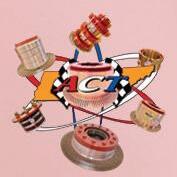
Circumventing typical OEM testing requirements might still enable inferior finished products to outwardly resemble any COMPLIANT modern high-performance v-ring type commutator to the untrained eye, but it’s a fact they’re NON-COMPLIANT due to lack of QUANTITATIVE TESTING RESULTS & therefore VASTLY MORE likely to experience expensive issues in the field. This is merely one of many perfect examples of the NEED to be ACTually CERTIFIED COMPLIANT! ™














Like ACT AKARD COMMUTATOR of TENNESSEE ACTion@commutator.expert • 1-800-889-ACTion! (2284) • FAX: 1.800.891. ACTion! WHEN YOU KNOW THE DIFFERENCE! TM See ACT’s latest video! Copyright © 1993 - 2024 ACT MANAGEMENT, Inc. Dba AKARD COMMUTATOR of TENNESSEE ( ACT ) ALL RIGHTS RESERVED
ELECTRICAL APPARATUS | APRIL 2024 9
The mid-year review
Understanding the benefits for both the underperformer and the overachiever
By Bill O’Leary, EA Contributing Writer
Ah, spring. Rejuvenation. Rebirth. Renewal. Flowers blooming and animals ascending from their gentle hibernation. Spring cleaning and allergy season. It’s a season of transformation.
Which is why spring also provides the idyllic setting for the mid-year review - the penultimate performance evaluation process to the year-end review. The midyear review is often viewed as the neglected sibling to its year-end brother, and many companies don’t even indulge in this particular structured, manager-led conversation. The reason for its paltry popularity makes sense, at least on its face.
Quite simply, the mid-year review isn’t directly tied to compensation, so there is less pressure to have a clear line drawn between ratings and monetary rewards. Budget planning, raises, and bonuses are the essential long-tail tasks from the year-end review. The other reason is psychological. The end of the year brings a specific weight and feeling of conclusion that begs for reflection.
More important than the end-of-year review?
But I’d hazard to say that the mid-year review is just as important, perhaps even more important than
the year-end review. Hear me out. The mid-year has optimal placement between goal-setting at the beginning of the year and final evaluation with all of its green-backed gifts at the end. It serves as a crucial checkin point with employees to reinforce goals. Which is much needed. According to a 2022 study from Betterworks, a Menlo Park, Calif.-based performance management software provider, 21% of employees said their goals are of the “set it and forget it” variety. They’re created and never looked at again.
A mid-year review as an immovable milestone reinforces your goals and sustains them across the year. Employees will be aware that they’ll be evaluated against these targets and ensure their contributions match the framework established by their managers. It’s easy for goals to get lost in the day-to-day shuffle if managers don’t hold themselves

Please turn to page 12
Feature | Electrical Manager — Illustration by denayunebgt/Shutterstock 10 ELECTRICAL APPARATUS | APRIL 2024



















Bartlett Bearing’s on-the-shelf inventory is unsurpassed and consistently stocked with a wide variety of quality products. With 6 fully stocked locations, our competitive pricing and 24/7/365 availability mean we are dedicated to being your go-to bearing distributor no matter your locale. We are proud to be an Authorized Distributor for major manufacturers including SKF, JTEKT, NTN, SLF, The Schaeffler Group, Timken, and many more.
Our seasoned team provides unmatched customer service and same-day shipping for every customer, every time.
Experience excellence with Bartlett Bearing.




INDEPENDENT AUTHORIZED BEARING DISTRIBUTOR bartlettbearing.com | 800-523-3382 | sales@bartlettbearing.com
EXACTLY
YOUR ORDER,
WHEN YOU NEED IT
ON-THE-SHELF INVENTORY UNBEATABLE SERVICE
Tips for conducting a mid-year review
Having a mid-year review is half the battle. How you conduct yourself in this setting should have equal focus. A rushed, disorganized, or antagonistic mid-year can backfire in spectacular fashion. Mid-years can be incredibly effective when done well, and here are a few tips to get there:
> Clearly tie the content of the review to the company’s goals and any individual goals you and the employee had established at the beginning of the year.
> Provide the written review to the employee the day before the scheduled meeting as a pre-read document. This allows the employee to absorb your feedback and not have the meeting be a dry walkthrough of the text.
> Along with sending the review in advance, encourage employees to come to the conversation with any questions and also express that you are looking forward to the discussion. This should establish a positive vibe up front and dispel any fear or anxiety the employee might be feeling.
> In the meeting, if your company provides ratings, cover those first and provide thoughtful justification, because that is often what the employee zeros in on. You want your employee engaging in the discussion, not feeling antsy because you haven’t addressed the “elephant in the room.”
> Always start with the positive. It creates a collaborative and encouraging dialogue and can help set the tone for the rest of the meeting.
> Provide specific examples of success. Saying “you really took ownership of this project” is a nice sentiment, but adding “. . . by setting up weekly meetings with the procurement team and establishing targeted improvement metrics” adds clarity for the employee to emulate that success later on.
That specificity is even more important if you are providing critical feedback. Many employees become defensive when receiving a negative message. With specific details like dates, events, and behavior at the ready, you can provide a convincing case that eliminates any confusion and hopefully softens those rigid edges of anger.
> Take a breather! This is supposed to be a conversation and you’re providing the framework and the material but always pause to get reactions, comments, or feedback from the employee. The performance review can feel like an intimidating environment, but you can punch through the power dynamic by making the employee feel like their voice is being heard.
> Ask them if they disagree with anything in the review. Often, employees can accept the general message but disagree with the specific wording or tone. Also, there might have been feedback from other business partners that was incorrect or mischaracterized. If their defense is convincing and has substance, you can remove or alter pieces of the review.
> On the subject of business partners, include direct quotes from work colleagues that you’ve gathered when soliciting feedback. It adds color to the review, a personal touch that emphasizes the importance of collaboration and partnership. It also provides insight on how others perceive that employee. Also, they are often very positive and encouraging, which can help elevate team culture. My direct reports often enjoy these parts of the review the most and have expressed how they appreciate their inclusion.
> Ask what you can do better. In a sense this is also a mid-year review for you! A team member’s performance, positive or negative, can be a reflection of your leadership, and it’s important to acknowledge this interdependent relationship by turning the bright lights on yourself.
> Set a roadmap for the rest of the year. Be clear about how a high performer can sustain this level of success and encourage them to reach even higher with specific examples of what they can do. Conversely, for employees who need to improve, provide clear recommendations and communicate the need to see progress in certain areas by year’s end.
> End on a positive note by circling back on accomplishments and progress and thanking them for their time. — BOL
MID-YEAR REVIEWS continued from page 10
accountable for promoting their importance. Midyear reviews ensure that every employee gets that meaningful reminder of what their company values and what they want to accomplish in the remaining months.
If the company is undergoing change, the midyear performance review can help steer everyone in that new direction. “Having clear and consistent goals with rewards to support them provides unambiguous support for the desired change,” said Donald L. Anderson in his book Organization Development: The Process of Leading Organizational Change. “Documenting these goals and expected results in the performance helps organizational members to focus on the activities that matter most in the support of change.”
Mid-years can also help managers dodge the scary surprised reaction from employees at year’s end. A performance review filled with shock, confusion, anger, and invective is a failed one. Employees should never be caught off guard, and the mid-year establishes that pipeline of communication for managers to send ringing encouragement but also “hard” messages if necessary. If an employee is starting to veer from the path, by failing to meet the bar on the “what” of their work — i.e., general performance in accomplishing their tasks — or the “how,” their soft skills, attitude, and communication, this performance conversation can help set them on the right path with much time to spare.
The benefits of mid-year reviews
That goal and role clarity can have long-term benefits for you and your team. A study from the American Management Association conducted at Ford Motor Co. found 25% of managers and their bosses disagreeing on the definitions of the managers’ jobs. After specific goal-setting activities, that lack of agreement was reduced to approximately 5%.
With the mid-year serving as the “tough love” conversation, the year-end is often viewed as the celebration of a year of growth and improvement. Essentially, the mid-year makes the year-end easier. At year’s end you can revisit what was covered in the mid-year and trace those specific action items to the present, determining whether the employee “got the message” and made the necessary course corrections. There should be no confusion or defensiveness because you’ve clearly outlined the areas of improvement in the mid-year. If done well, the midyear is the climax of a worker’s story, and the yearend is the falling action and conclusion that fits with the established narrative.
And for those high-potential high performers, the mid-year is equally as important. Here, managers can provide the encouragement to sustain that el-
12 ELECTRICAL APPARATUS | APRIL 2024

elevated bar and even try to move it further. Many employees are galvanized by positive reinforcement, and the mid-year allows managers to make those top employees feel valued and supported. It provides that energy to continue delivering for the remainder of the year.
Managers can also use this meeting as an opportunity to structure development opportunities and discuss what other roles or responsibilities the employee might be interested in. Instead of waiting six long months to deliver this vote of con dence, you can use that time to set up stretch work and make connections across the business. And from that, the outputs of a successful mid-year make a whole lot of sense — improved morale, increased engagement, and higher retention to name a few. But how do you go about conducting a mid-year review? Some suggestions are listed in the accompanying sidebar.
Following up afterward
Use your daily, weekly, or monthly conversations with employees who have gone through a mid-year review to follow up and ensure that they’re continuing on the right track. Performance reviews should not be viewed as isolated events but larger, focused conversations that are built up over time. The days in between are just as important, because they provide the content for these conversations.
There is nothing middling about mid-year reviews. Managers should view them as a time to celebrate strong work and behaviors and address substandard work and negative attitudes. It’s a halftime speech to encourage your team, no matter if it’s a blowout or a close game. Mid-year and yearend reviews should be viewed like parts of the same game. And with that attention and guidance, as the coach you can lead everyone to positive results — the team wins but also each team member feels like a valued contributor. EA

GLOBAL SOURCING UL CERTIFIED TO SLIT 3M TAPES
MANUFACTURING
RES-I-LAM - NMN, DMD 180, NKN LAMINATES | RES-I-GLAS & POLYGLAS BANDING TAPE | RES-I-STRAINT EDGING


TAPE | RES-I-FLEX ARMOR TAPE | B-STAGE SURGE ROPE & FELT | RES-I-BAND BANDING FILM CONVERTING THERMAVOLT / TUFQUIN / CEQUIN INSULATING PAPERS | ELANTAS HT180 FILM | DIAMONDDOT& PRE-PREG PAPERS |ARAMID, POLYESTER,POLYIMIDE, POLYAMIDE,& PEEK PRODUCTS BYDUPONT, 3M, & ST. GOBAIN DISTRIBUTING LENNI, VARFLEX, 3M, KANEKA, IPG, IDP, ATKINS & PIERCE, KREMPEL, ISOVOLTA, HESGON, ST. GOBAIN, DUNBAR, DELFINGEN MANUFACTURING lCONVERTING l DISTRIBUTING THE RIGHT SOURCE, RIGHT ON TIME. SALES@PEIPITTSBURGH.COM ESPANOL@PEIPITTSBURGH.COM (412)462-6300 (EN) | (956) 554-3690 (ES) WWW.PEIPITTSBURGH.COM CALL US FOR A QUOTE TODAY. 800.462.4734 A mid-year review can help steer an employee toward better future productivity as well as evaluate the employee’s past performance. It can also help prevent unpleasant end-of-year surprises for both the employee and the employer. — Image by storyset on Freepik ELECTRICAL APPARATUS | APRIL 2024 13
Know Your Industry
Not your average institute
Edison Electric Institute
Founded: 1933
Headquarters: 701 Pennsylvania Ave. NW, Washington, D.C. 20004
Annual dues: dependent on membership type
Phone: (202) 508-5000
Website: www.eei.org
Electricity is such a natural part of modern homes, life, and work that it is easy to take it for granted or forget how dependent on it everyone is. Sometimes it takes a power outage to remember that electricity is needed for internet connections, most media consumption, and often cooking appliances. These functions are so much a part of everyday life that they are not thought about until you are roaming around the house looking for a ashlight during a thunderstorm. Luckily, before anyone believes they need to invest in messenger pigeons or a hamster on a wheel to power their home, the Edison Electric Institute (EEI) is here to support electricity providers.
Named after one of America’s most famous inventors and proponents of electric power generation, Thomas Edison, the EEI is a trade association consisting of all U.S. investor-led electric companies, 70 international electric organizations, and 250 associate members.
Calling a trade organization an “institute” might be con-
of an organization. As an institute, it o ers a level of sustainability, advocacy, and a crucial role in society, especially as electricity became a prominent power source. Its vision, according to EEI, is to contribute “to the long-term success of the electric power industry in its vital mission to provide electricity to foster economic progress and improve the quality of life.”
The Edison Electric Institute was established in 1933 to unite e orts to advocate for the electric power industry and encourage reliable and affordable energy. The Institute is smartly situated in Washington, D.C., which keeps it near the heart of decisive energy policy development. This advocacy work includes member involvement through committees and publications..
One such initiative was formed in December 2021 when EEI announced the formation of the National Electric Highway Coalition, which brought together the rst fourteen member companies joining forces to bring fastcharging electric vehicle charging stations to major roadways across the nation. The (now sixty) members of the coalition have invested more than $4 billion since its formation. The commitments of the coalition members ultimately link back to the EEI advocacy for clean energy, and according to an article in EEI’s Electric Perspective magazine, “continue to reduce their carbon emissions and invest in the clean transportation system of the future.”
In recent years, clean energy and climate action have been a focal point of the Institute’s policy engagement, but EEI hasn’t limited itself to meeting with state and federal legislators. EEI leaders and key member company representatives attended co-located events for COP28, the United Nations’ climate conference. Its delegation attended six events discussing electric transportation, energy storage, and reaching “net zero.” Clean energy is also a crucial topic for the annual EEI conference, which brings together electric industry leaders, government o cials, and innovative business guests for three days.
The EEI conference also hosts the Edison Awards, which date back before the formation of the Edison Electric Institute. The Edison Awards are given





















14 ELECTRICAL APPARATUS | APRIL 2024

to electric companies that have demonstrated “distinguished leadership, innovation, and contributions to the advancement of the electric industry for the bene t of all,” according to an article in the May/June 2023 issue of EEI’s Electric Perspective magazine.
While the EEI website is home to member-exclusive bene ts like industry data and a resource center, one of its most interesting pages is available to anyone visiting the site. The a liate page “Get into Energy” provides information on careers in various energy sectors and starting on a new career path. It even features a quiz for those uncertain of what energy career would suit them. The page is run by the Center for Energy Workforce
Development, or CEWD, created for career changers, teachers, students, and military veterans. CEWD is a collaborative venture between EEI and nine other energy associations, including the International Brotherhood of Electrical Workers and the American Gas Association.
Another aspect of the EEI website that stands out is the rising energy costs section, which is aimed at consumers with an interactive map providing information on available energy bill assistance in each state. When a state is clicked, the various electricity providers in the state are listed at the bottom of the section. Each is linked to the providers’ web pages detailing energy bill assistance. It works as a helpful tool to consumers and a guide for members to see what each is o ering its customers.
So how does the EEI connect to Electrical Apparatus readers? Whether you repair motors or manufacture carbon brushes, the e orts of the Edison Electric Institute shape much of the country’s electricity policies and use. Much like its namesake, the Edison Electric Institute’s in uence on electric vehicles and energy access and costs is a big part of everyday activities. Now if only we didn’t forget to turn o the lights when the shop closes. — Kristine Weller EA

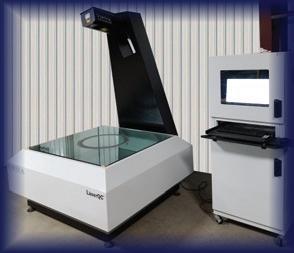






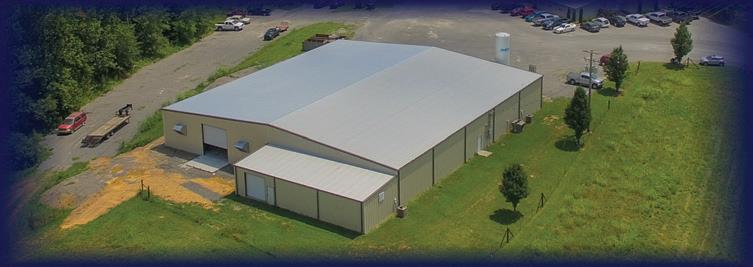














ELECTRICAL APPARATUS | APRIL 2024 15
—
This map from the National Electric Highway Coalition shows the network of roadways across the U.S. that are served by charging stations for electric vehicles.
EEI illustration
Calendar
Update your calendar with these upcoming trade shows, conferences, and other events.
• April 7-9, 2024 — EGSA Spring Conference, Hyatt Regency Miami, Miami, Fla. Electrical Generating Systems Association, https://egsa.org/Events/Future-Con ferences.
• April 7-10, 2024 — EERA 2024 Annual Meeting, Ritz-Carlton Laguna Niguel, Dana Point, Calif. Electrical Equipment Representatives Association, https://web. eera.org/events.
• April 15-17, 2024 — NECA Emerge 2024, MGM Grand, Las Vegas, Nev. National Electrical Contractors Association, www.necanet.org/events.
• April 19-20, 2024 — PEARL Annual Conference and Exhibition, Westin Denver Downtown, Denver, Colo. The Professional Electrical Apparatus Reconditioning League, https://pearl1.org/2024-confer ence.
• April 22-26, 2024 — Hannover Messe 2024, Hannover Fairgrounds, Hannover, Germany. Deutsche Messe AG, www.han novermesse.de/en.
• May 5-7, 2024 — Facility Fusion 2024, The Westin at Boston Seaport District, Boston, Mass. International Facility
Adjustable Motor Base keeps improving!

Our Adjustable Motor Base is continuously improving to be the most durable and longlasting motor base on the market. With the latest patent pending advancement, Overly Hautz motor bases now last 5 to 9.5 times longer than the competition. Decrease downtime and save money with extended motor base life cycles. Read the verified factory test report at: www.overlyhautz.com

Management Association, https://facility fusion.ifma.org.
• May 6-9, 2024 — CleanPower 2024, Minneapolis Convention Center, Minneapolis, Minn. American Clean Power Association, https://cleanpower.org/events/ cleanpower-2024-conference-exhibition.
• May 14-16, 2024 — CWIEME Berlin, Messe Berlin, Berlin, Germany. Coil Winding, Insulation & Electrical Manufacturing Exhibition, https://berlin.cwiemeevents. com/Home.
• May 21-23, 2024 — National Association of Electrical Distributors 2024 National Meeting, JW Marriott Austin, Austin, Tex. National Association of Electrical Distributors, www.naed.org/nationalmeeting.
• May 22-24, 2024 — Europump Annual Meeting, De Vere Beaumont Estate, Windsor, U.K. Europump and the British Pump Manufacturers Association, www.europump2024.com.
• June 22-24, 2024 — 2024 ASHRAE Annual Conference, JW Marriott Indianapolis, Indianapolis, Ind. American Society of Heating, Refrigerating and AirConditioning Engineers, www.ashrae.org/ conferences/2024-annual-conference-indi anapolis.
• June 23-26, 2024 — EASA Convention 2024, Caesars Forum and Harrah’s Casino Hotel, Las Vegas, Nev. Electrical Apparatus Service Association, https:// easa.com/convention.
• June 24, 2024 — Hydraulic Institute 2024 Technical Conference, Portland Marriott Downtown Waterfront, Portland, Ore. The Hydraulic Institute, www.pumps. org/event/2024-technical-meeting.
• August 7-9, 2024 — Safety 2024 Conference & Expo, Henry B. Gonzalez
Convention Center, Denver, Colo. American Society of Safety Professionals, https:// safety.assp.org.
• September 9-14, 2024 — IMTS 2024, McCormick Place, Chicago. International Manufacturing Technology Show, www. imts.com.
• September 15-17, 2024 — EGSA Fall Conference, Hyatt Regency Bellevue, Bellevue, Wash. Electrical Generating Systems Association, https://egsa.org/Events/ Future-Conferences.
• September 15-18, 2024 — Power 2024, Washington, D.C. [venue to be announced]. American Society of Mechanical Engineers, https://event.asme.org/power.
• September 19, 2024 — Golf Day 2024, Portal Golf & Spa Resort, Tarporley, Cheshire, U.K. British Pump Industry Association, www.bpma.org.uk/home.
• September 25-27, 2024 — AEE World Energy Conference & Expo, Music City Center, Nashville, Tenn. Association of Energy Engineers, https://aeeworld.org.
• October 7-10, 2024 — The Battery Show North America, Huntington Place, Detroit, Mich. The Battery Show, www.the batteryshow.com/en/home.html.
• October 15-17, 2024 — Fabtech 2024, Orange County Convention Center, Orlando, Fla. Fabtech Event Partners, www. fabtechexpo.com.
• November 12-14, 2024 — NEMA Annual Meeting, Kiawah Island, S.C. National Electrical Manufacturers Association, www.nema.org/about/events.
• January 22-24, 2025 — AHR Expo, Orange County Convention Center, Orlando, Fla. The Air-Conditioning, Heating, and Refrigeration Institute, www.ahrexpo. com. EA
Edited by Kevin Jones
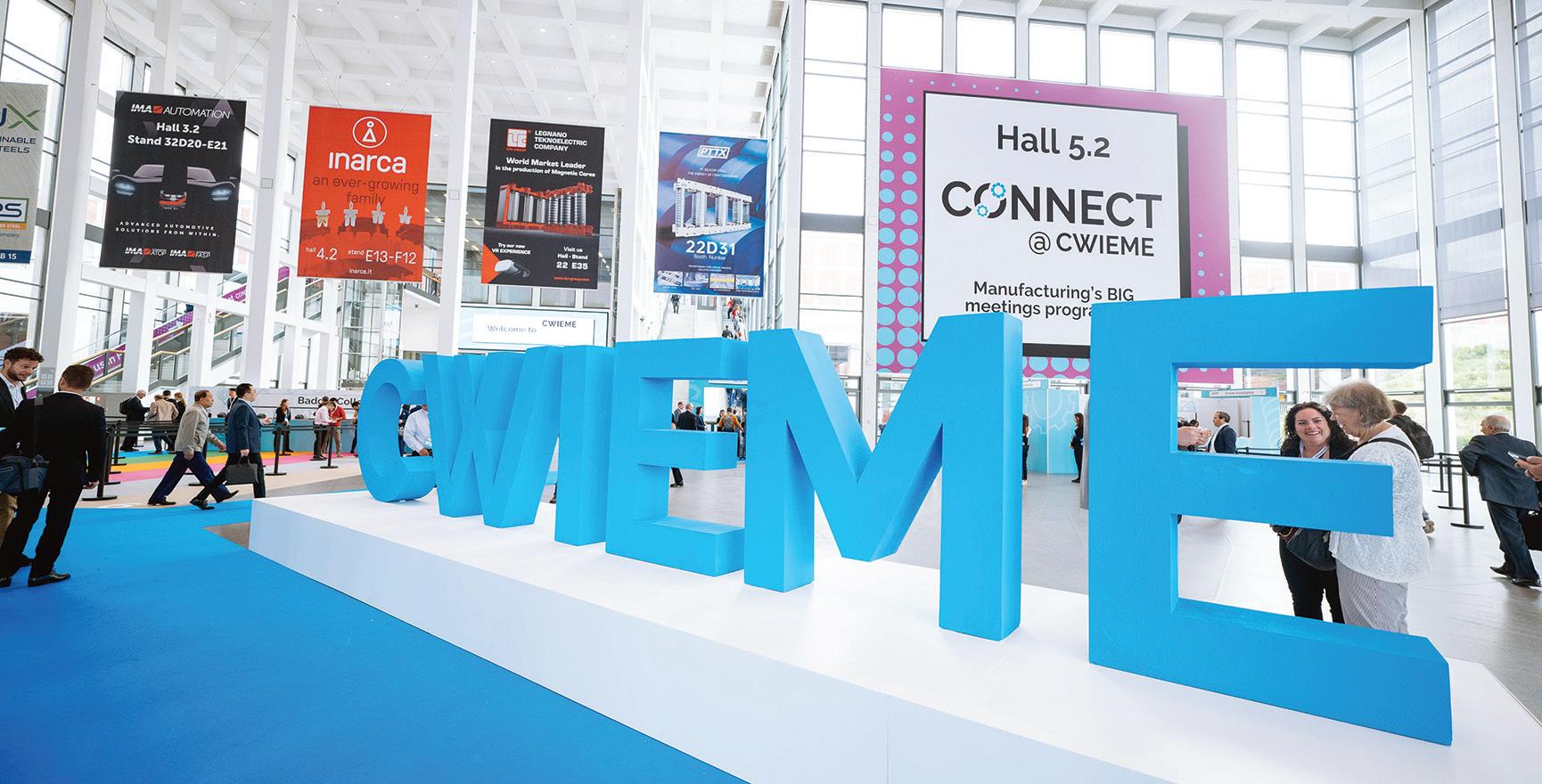
What’s said to be the world’s largest international trade fair and conference dedicated to the coil winding and electrical manufacturing industry will return to Berlin, Germany, next month when CWIEME Berlin is held May 14-16. The annual event brings together manufacturers, suppliers, and industry professionals from all over the world; last year, more than 5,000 visitors from 88 countries came to see over 600 exhibitors. Once again, the popular Connect @ CWIEME will serve as a nexus through which potential buyers will be matched with sellers. — CWIEME photo
16 ELECTRICAL APPARATUS | APRIL 2024
“CONTINUALLY IMPROVING THE BEST MOTOR BASE” TM
TM


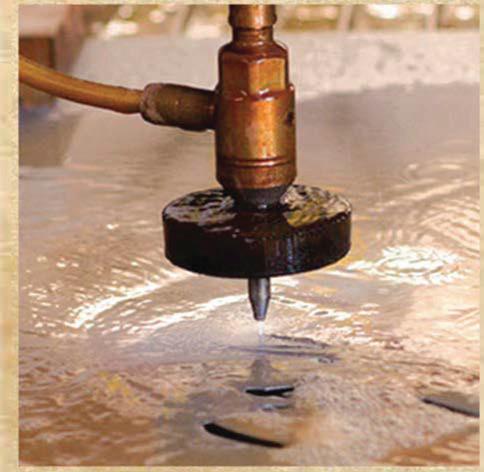








Codi- ·1 D ,.. , _ ic ... 1, ,,.., .. ::__ ------· ) .., , ;.co,� Ce- ·e�.r/ �) .Ji •. -=--- __J ---=-__J Founded in 1973, by Bob Ross, Jasper Electric has provided quality motor and rotor repair by being on the cutting edge of technology and using high-quality materials, such as Ml 9 electrical steel. Handling large and small motors alike, we are the future. We have almost every tool needed to repair or rebuild your rotor and stator. Most motors we repair will run as efficiently if not better than when they were new from factory. Our personnel allow us to work smoothly while giving our customers a peace of mind. JASPER ELECTRIC MOTORS INC. The Electro,Mechonlcol Authority & Armature Cores• Fiber Optic Laser Cutting• Large Machine Shop• Water Jet• Loose Lams Core Loss & 15' VPI , 300 KVA 20 HP to 10,000 HP • Computer printout sent with eidl .klb , Water stripping for fmn v.ound stators , Full rewindwith 15ftVPI available , 1 HP to 10,000 HP • Infrared hot spot check on each job • Quality core loss report with each job , Loop testing for 10,000 HP+ stator cores Motor Load Testing Laminations , Full 4-Hour load test available or until • Punch or laser cut temperature stabilizes • Pole pieces (laser cut) , Load test up to 1500 HP A(. 925 HP DC • Any size or thickness , Voltage test up to 7200 volts A(, 600 volts DC •Emergency pick-ups , Run test as long as necessary, 7500 HP , Emergency deliveries , Government and utility approved , Segment or whole • Synchronous motor testing • Estimate over the phone , Computer print-out with efficiency rating I TWO SERVICE LOCATIONS! Box 1494 • 175 Curry Hwy•Jasper AL 35502 205-384-6071 • Fax 205-384-6073 jemi@bellsouth.net 0 22673 Hand Rd • Harlingen • Texas 78552 /-, 1 956-421-2446 • Fax956-421-3616 �m/ info@newcoreinc.com , R.D.T. Available • On-site quotes and repairs • Stacked in your housing, spider/shaft or shipped loose New Rotors • All copper alloys to match conductivity , Normal turnaround 15-24 Days • In house aluminum and copper extrusion , R.O.T. Available NEW CORE INC. newcoreinc.com G FACEBDDK.CDM/ NEICDREINC Gt IN STAG RAM.COM/ NEICDREINC Majority woman-owned busines
Going beyond EVs
In light of the shortcomings of electric vehicles, alternative fuel sources are being considered
By Maura Keller, EA Contributing Writer
In recent years, advancements in alternative fuels and technologies, including EV and hydrogen fuel cell technologies, have taken the transportation industry by storm. With ongoing efforts, commercial fleets and individual consumers are vetting these alternative fuels and technologies and determining their use and viability for transportation. And as vehicle manufacturers make statements concerning how soon they will be eliminating internal combustion engine (ICE) technology and embracing these alternative energy options, what the future of the alternative energy vehicle industry will look like is anyone’s guess.
Faced with high-energy costs, environmental concerns by consumers, and government regulatory measures, the world’s leading automakers are embracing new technological advancements to make today’s vehicles more fuel-efficient and environmentally friendly than ever before. One alternative vehicle technology, electric vehicles, is making inroads in the minds of consumers who are eager to “go green” and leave a smaller carbon footprint. But are EVs truly the way of the future or are other alternative energy sources going to emerge as the key method by which vehicles operate?
In the West, EVs not a priority
that many of the Western EVs are being placed on the backburner.

“GM last year invested nearly $4 billion for ICE vehicles despite previously pledging to ‘go all in’ on EVs, whereas BMW, Toyota, and other manufacturers have switched over to hydrogenbased cars. And Tesla, despite slashing prices, has been radically underperforming on the market for the past year. So, while the number of EVs produced has risen, the expectations for the percentage as well as absolute numbers of Western-made EVs and even EVs in general have not been met,” Tsukerman said.
The U.S. continues to experience a very slow rise in EVs due to the fact that most people in the country simply do not have the charging equipment that could meet the demand. Rental companies like Hertz are increasingly burdened with EVs that are seen as a liability for long-distance travel.
Irina Tsukerman, business and geopolitical analyst, president of Scarab Rising, Inc., a media and security strategic advisory, and program vice chair of the American Bar Association’s Oil and Gas Committee, said

“On the other hand, the rise of EV vehicles in government fleets like buses is linked to specific subsidies and other policies encouraging reliance on EVs,” Tsukerman said. Moreover, technical issues in places like New York City have caused significant security concerns. These issues included 13 deaths by fires from the EVs in the first seven months of 2023 in New York City alone, aside from injuries, as well as two recalls and production-related strikes, which have likewise caused delays.
“Electric vehicles are facing multiple setbacks in the early weeks of 2024, including slowed demand and unreliable charging networks,” Tsukerman said. “On the other hand, developing economies and booming states like India find manufacturing relatively cheaper EVs (with raw materials easy to access), an easy source of quick income.”
Feature | Electric Avenue
Rental car companies like Hertz are at the forefront of implementing EVs, but they’re starting to feel the weight of the associated costs and drawbacks, such as charging infrastructure and range concerns.
— Hertz photo
18 ELECTRICAL APPARATUS | APRIL 2024
Irina Tsukerman
EVs versus other options
Tsukerman says that hydrogen-based cars and EVs with alternate batteries such as the sodium-ion batteries currently breaking into Japanese manufacturing are the future of “going green,” despite cost-related barriers to R&D at the moment.
“And a return to the hybrid model, which combines the best features of EVs and ICE vehicles without the expense and the raw material limitations, may be forthcoming,” Tsukerman said. In terms of the immediate benefits of EVs, these include smaller carbon footprint, lower operating costs (excluding the costs of dealing with fires and weatherrelated issues), lower maintenance needs and costs, high performance/energy efficiency, convenience of charging at home (which explains the popularity of EVs among short-distance Uber drivers and other car-sharing drivers), and EV-only parking spots. The cons include EV charging station shortages and general inefficiency, the limitations on driving range at full charge, higher initial purchase cost, high battery replacement costs, low endurance at low temperatures, and the propensity towards fire hazards.
mass expansion of EV use can contribute to blackouts like the ones becoming more frequent in California, and electric grids, if not managed properly, are an easy target for cyber-attacks. Moreover, the process of electrification is not necessarily any more environmentally friendly than natural gas, which is considered a ‘clean’ energy option in Europe.”
Skepticism about EVs
John Berman is founder and chief investment officer of Berman Capital Group, an investment management company that employs multiple strategies focused on global opportunities in traditional energy, renewable energy, minerals, infrastructure, and carbon credits.

Tsukerman further stressed that EVs are arguably a potential future contributor to an energy crisis. This is due to the reliance on expensive raw materials that are difficult to procure and which the U.S. and other Western countries are not likely to be able to manufacture independently in sufficient quantities and break through the market due to assorted geopolitical and commercial limitations.
“The process of electrification is costly, inefficient, linked to assorted secondary concerns, and is a huge strain on power grids,” Tsukerman said. “Without investing into building up relevant infrastructure,
Berman said EVs are not better for the environment than ICE vehicles; the pollution is just outsourced to other parts of the world.
“All the additional mining required to get the battery metals requires diesel-powered mining equipment, and the mining is often done by Chinese companies in places like the Congo, not known for their rigorous environmental standards,” Berman said. “Additionally, most EVs are charged by electricity that was generated from the burning of coal or natural gas, so they are not nearly as ‘green’ as the marketing material would lead one to believe. If we build out our grid with cleaner energy sources like nuclear for base load power generation, then EVs will become the ‘greenest’ option, but I think that is a story that will be told in decades, not years.”
However, as Phil Dunne, U.K. managing director at the global strategy consulting firm Stax, explained, the general population is still wary of EVs, with concerns around range, charging infrastructure, second-hand values, etc.
“Huge improvements are going to come over the next five years as new battery technologies evolve. Lithium-ion batteries are the current standard, but there are already a number of different technologies, including lithium iron phosphate and lithium nickel manganese cobalt, which each refer to different materials used in the cathodes and anodes

THE WIDEST PRODUCT PORTFOLIO FOR THE ELECTRICAL INSULATION INDUSTRY We Enable Energy POTTING COMPOUNDS RESINS & VARNISHES FLEXIBLE LAMINATES MICA TAPES CORONA PROTECTION TAPES COATED PRODUCTS COMPOSITES CONTACT US sales.us@vonroll.com
Please turn to next page ELECTRICAL APPARATUS | APRIL 2024 19
John Berman
linked by a liquid electrolyte,” Dunne said. Changing the chemistry using different cathode and anode materials operating within a liquid electrolyte can change the efficiency impact.
Dunne said the next big improvement will come with solid-state batteries that replace the liquid electrolyte with a solid. The emergence of production-ready solid-state batteries is currently being developed by Toyota and Volkswagen for anticipated scale production by 2027.
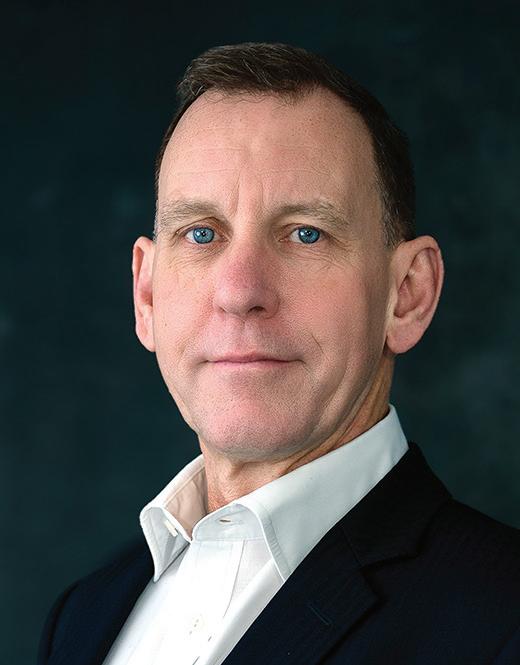
“We are also going to see huge changes in charging infrastructure and recycling EV batteries through secondary use as stationary storage units to recovery of the constituent materials for reuse in next-generation batteries,” Dunne said.
The long-term promise of hydrogen
So what role is hydrogen expected to play in the future of vehicle development? As Tsukerman explained, hydrogen cars, if the development cost barrier is overcome, seem more promising in terms of suffering from fewer of these shortcomings – being less dependent on raw materials, having longer driving range, better function at low temperatures, and better safety. “The charging issue is also less likely to be a burden as are overall costs to consumers,” she said.
However, due to the impact of lobbying, the U.S. has almost completely oriented its markets towards electrification in absolute numbers despite recent government efforts to push for hydrocarbons.
“Hydrogen will take a long time due to costs of R&D and the fact that there are only five leading countries, and none have invested sufficiently to make hydrogen into an immediately available reality,” Tsukerman said. Countries like Morocco need huge amounts of direct investments to develop the infrastructure for hydrocarbon manufacturing. And while Saudi Arabia has the means to push this issue heavily, it lacks the know-how to move hydrocarbons to the forefront of R&D in the foreseeable future. Tsukerman added that this means hydrogen leaders will need to work closely together and coordinate their efforts to turn hydrogen into reality.
“Japan is leading on the hydrogen-based vehicular breakthroughs but lacks the lobbying clout to sell the product and to attract sufficient investments that would make ROI worthwhile in the short term,” Tsukerman said. “Moreover, it is heavily reliant on imports of hydrocarbons for its R&D, and those are expensive due to the lack of overall global investments.”
However, at least as it relates to ground transportation, Berman believes EVs are here to stay.
One case for hydrogen that he sees is using it for aircraft, as lithium-ion batteries are too heavy to supply all the energy an airplane needs for a flight, but he thinks that reality is also decades away before that becomes the industry norm.
“I think in the near term (next 10 years), hybrid vehicles will gain more traction, especially in commercial vehicles (freight trucks, mining equipment, etc.), as current battery technology can’t provide the range that these kinds of trucks need,” Berman said.
Overall, Berman does not think that there are other viable options as far as decarbonization is concerned (other than more fuel-efficient ICE vehicles), but we are seeing that EVs currently still have real limitations that make it hard to compete with ICE vehicles.
“Hydrogen fuel cell-powered cars have not really been able to compete with EVs because of the hydrogen infrastructure that would be required, which is much more complicated (transportation of compressed hydrogen) than the charging infrastructure required of EVs,” Berman said. “In the long term, nuclear is the only viable low-emissions power source; the public perception of nuclear has been badly damaged but it really is an extremely safe technology.”
Public perception of nuclear seems to be coming around a bit, but only time will tell. As Berman explained, other than hydroelectric, nuclear is the only technology that can produce emissions-free base load power generation.

“The energy transition is going to take decades longer than many people want to believe. In the meantime, there should be additional investment in natural gas to replace coal-powered plants,” Berman said. “While natural gas does produce emissions, it produces far less than thermal coal, and natural gas is the least bad option. There are a lot of limitations to renewable energy (limited battery storage capacity, and intermittency), which may be solved with time, but the perfect is the enemy of the good in the effort to decarbonize.” EA
Phil Dunne
BEYOND EVs continued from previous page 20 ELECTRICAL APPARATUS | APRIL 2024
A fuel-cell hydrogen-powered bus operating in London. Hydrogen-powered vehicles are more feasible in fleets and situations that involve tax credits. — Energy Hydrogen Alliance photo
The hand of providence
For Rodney Fuller, good things have a way of following hard work
By Colin Gregory-Moores, EA Contributing Writer
Rodney Fuller has lived and worked most of his life in southern Tennessee. His parents were part of that Greatest Generation and closer in age to that of his friends’ grandparents. He describes them as being very responsible, fairly conservative, and hardworking.
“I don’t know if it was just from growing up in that era, but you never heard them complain. Didn’t matter how hard things got, they kept on going.” Rodney says in a southern voice reverberating with warmth. His father was a Baptist preacher, who ministered and whose faith guided him through life. It was kind of a natural progression that Rodney would follow in his father’s footsteps as an electrician, just like his older brother some sixteen years before him, and just like his youngest son would do.
“My Dad was always doing work on the side to help people, not even getting paid. . . . I was the one who crawled under the house pulling wires and sticking them through the hole,” he infectiously laughs. Rodney’s father set him an example in everything he did, just like Rodney would do later for his two sons. “He was a very gifted craftsman; he



could do anything. So just being around him growing up, I picked up a lot of his skills. I’m a lot like him.”
Lessons in responsibility
Rodney nished Sequoyah Vocational School in 1979 and Soddy Daisy High School in 1980 before enrolling at the IBEW/NECA Joint Apprenticeship Training Center – Local 175 Chattanooga, where he graduated in 1985. At 16, he got his driver’s license and an evening job at an Ace Hardware store. The money he earned went towards his car. “My dad taught me early on that when I got my car, I’d have to pay half on the purchase, and all of the cost for gas, upkeep, and insurance. It didn’t move if I didn’t.”
As an apprentice, Rodney worked 40 hours per week with an electrical contractor, while two nights a week he attended school for three hours. When he















Feature | EA Reader Profile 22 ELECTRICAL APPARATUS | APRIL 2024 ♦ Build relationships with leading manufacturers and suppliers of electric motors, predictive and preventative maintenance equipment, bearings, pumps and pump supplies and more during the EASA 2024 Solutions Expo. ♦ Get in tune with expert-led training on topics ranging from technical skills to sales management and marketing. ♦ Solidify and develop relationships with electromechanical professionals from around the world! ATTEND THE HIGHLIGHT EVENT OF THE YEAR FOR ROTATING EQUIPMENT! SOLUTIONS EXPO ♦ JUNE 24-26 CONVENTION ♦ JUNE 23-26 Caesars Forum & Harrah’s Las Vegas Register today at easa.com/convention! 1331 Baur Blvd. • St. Louis, MO 63132 USA +1 314 993 2220 • easainfo@easa.com •easa.com easa.com/convention
graduated, there was no work to be had in Chattanooga. At the age of 23, he went down to Augusta, Ga., showed them his union ticket with his electrician license, and his journeyman inside wireman classi cation, and they referred him to the Vogle Nuclear Plant in Waynesboro.
In 1981, when he was 19, Rodney married his sweetheart Kelly, and together they built their rst home. They did all the inside work, from the insulating to the electrical work and drying the walls. Rodney even got a plumber to show him how to solder pipes so that he could do the plumbing too.
“It took about nine months before we could move in, but it was ours. It was a little 1,000-square-foot home. We lived there for 16 years.” Towards the end of nishing the house, they ran out of money for the septic tank and had to sell his wife’s car to pay for it. In 1985, just before they went down to Waynesboro, where they rented property, their rst son was born.
“We had the little one with us. The whole bit,” Rodney proudly smiles. Just like Rodney’s parents, he and his wife were making their own conditions and taking responsibility for their actions.
Rodney’s path from 1985 to 1991 took him from nuclear and fossil plants to working for an electrical contractor, where he was soon running jobs from the ground up by himself. He enthusiastically recalls doing the electrical controls for a water plant, high-voltage work for the local hospital, as well as lots of other commercial and industrial wiring construction and trouble-shooting projects. Rodney abounded in work.
“The more of these projects that I did, the more I just got better at them. My goal was to never have the architect or electrical engineer looking over my work nd things that were not quite nished.”




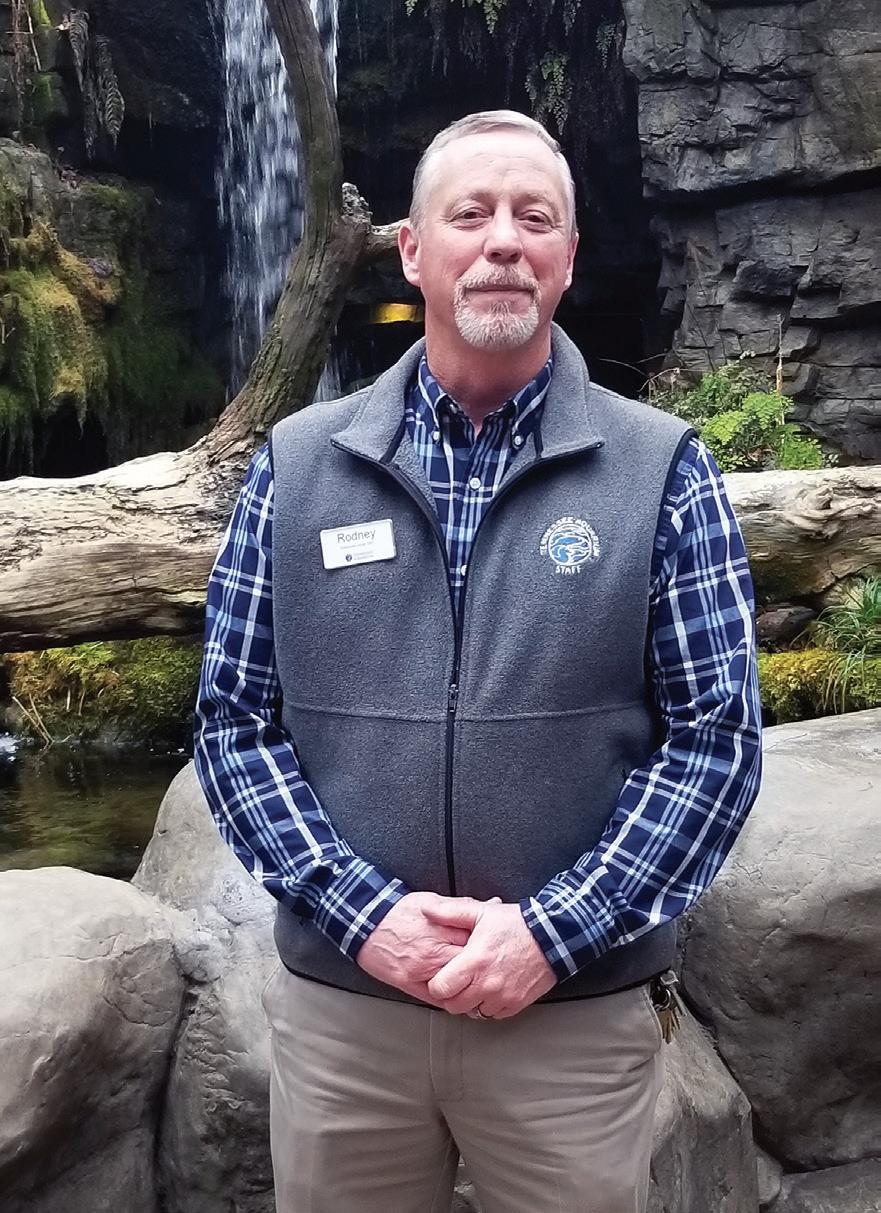
Besides being a perfectionist, Rodney is a universalist. He always wants to know the whole kit and caboodle. “I loved to observe the other trades. I’d always corner somebody and say, ‘Hey, show me how
Please turn to next page

WORLD. LEADING. INDUSTRYSHOW. HANNOVER MESSE 2024 ENERGIZINGA SUSTAINABLE INDUSTRY Products and solutions at #HM24 22–26 April 2024 Hannover, Germany hannovermesse.com
ELECTRICAL APPARATUS | APRIL 2024 23
Rodney Fuller in the River Journey Aquarium Appalachian Cove Forest Exhibit. — Tennessee Aquarium photo
to do that.’ And I just kind of self-taught myself.”
As an electrician doing a lot of control work, Rodney was also curious about the processes and the sequence of events behind the controls. All this know-how would serve him well at the Tennessee Aquarium in Chattanooga. “An aquarium is a lot of things in just one building,” he says.
Life at the new aquarium
The year 1990 finds Rodney working on the installation of the building automation, and aquatic life support control systems for the new Aquarium that was being built. When he got there, the builders were already pouring the third floor of the building.
“I had this superintendent who was just riding my case pretty hard.” One day, he came by and started hollering at Rodney, “Where are the controls?” Rodney showed him all the wire that was waiting for devices to be delivered. From that point on, they got along so well that the superintendent later went to the Aquarium officials: “When you get ready to hire somebody to take care of this place, you need to go and see that young man.” Since he had a family, Rodney had been hoping that he’d find permanent work in town. His prayers were answered.
Starting there as construction and maintenance manager and having been awarded numerous promotions, Rodney has been director of facilities and safety since 2017. During his time at the Aquarium, he has been given the task of overseeing construction projects, assembling a maintenance team for the complex, and handling installations; he has been
involved in various large capital projects (the Aquarium buildings now cover an area of 317,497 square feet), has introduced a computerized maintenance management system, and has developed organizationwide health and safety regulations and procedures that helped to reduce the facility’s EMR to an astounding 0.64.
One recent project, he recalls, was the replacement in 2020 of the thirty-year-old standby diesel engine situated between two large glass peaks on the sixth floor of the Aquarium with a CAT D350 GC (60 Hz) generator. The crane company belongs to Rodney’s old Ace Hardware buddy of 44 years ago. “I always have a back story,” Rodney laughs. “It’s almost spooky.”
Reflecting on his good fortune
After some 32 years, he still immensely loves his work, mostly due to the people: “They are really what make this organization the success that it has become. I am so blessed to work and have worked with such talented people who enjoy what they do.” Rodney subscribes to Electrical Apparatus magazine and passes it around to his electricians to read. “All things that are covered in the magazine, we’ve got them. The articles are very informative.”
Whether walking through the echoing halls of the Aquarium after closing or trekking on nature trails, Rodney never ceases to wonder at the fair raiment of nature. There is the sea, vast and spacious, teeming with creatures beyond number, and there are the mountains and forests where he loves to spend his time with Kelly, his wife of 42 years, their six grandchildren and dog Marley.
Rodney is fortunate that he and Kelly, their two sons and families live in the same community and get to enjoy a lot of time with each other. “And to top it off, we are able to attend church together as well,” he adds. Like his father, Rodney has always worked hard for his family, his coworkers, and his community. He feels blessed to have the life he leads and the talents to serve others. You might say that the hand of providence watches over him.

EA EA READER PROFILE continued from previous page 24 ELECTRICAL APPARATUS | APRIL 2024
The Aquarium’s River Journey basement pump room houses equipment to manage water circulation, filtration, aeration, and specialized tasks. — Tennessee Aquarium photo
Precision Coil and Rotor buys an Oklahoma City coil company
Precision Coil and Rotor of Birmingham, Ala., a division of Jay Industrial Repair, has purchased Industrial Coil, Inc., of Oklahoma City, a family-owned and -operated electric coil wholesaler that manufactures electric motor, stator, generator, d-c field, armature, and rotor coils. The company also offers coil customization and special wrapping and turn taping. Industrial Coil was founded in 1982 by Paul Kemp, Doug Kemp, and Ron Pittman.
Joel McMahon, owner and CEO of Jay Industrial Repair and Precision Coil and Rotor, said the acquisition will help sustain Precision’s growth and will aid in serving partners in the western U.S. “more effectively and efficiently.” The acquisition will also further Precision Coil’s objective “to safely provide customers with the highest quality of products and services on time while continually improving processes is aligned with their mission.”
Precision Coil and Rotor manufactures electric motor, stator, generator, d-c field, armature, and rotor coils using “the latest equipment and techniques to manufacture our products,” the company says. Precision Coil and Rotor’s specialty is manufacturing and rebuilding of component products for rotating electric machines up to 13.8 kV.
Siemens buys a machine vision software maker
German electrical and electronics manufacturing giant Siemens recently upped its automation game by acquiring Inspekto, an AI-enabled machine vision software company headquartered in Heilbronn, Germany. The products manufactured by Inspekto enable manufacturers to automate visual inspection without vision experts and intensive production data.
Inspekto will become part of Siemens’ Digital Industries Factory Automation unit, with headquarters in Nuremberg, Germany. Siemens calls Inspekto’s innovative AI technology “a valuable addition to the Siemens industrial AI software portfolio.” The stock of Inspekto is to continue being traded independently of that of Siemens.
Inspekto’s flagship product, the S70, is described by its manufacturer as “a fully equipped out-of-the-box industrial visual inspection product with unprecedented simplicity and immediacy that can be operationally deployed in less than a day.” The S70 can be used in a variety of applications, such as connector verification, robotic inspection of electronic components, verification of oil pump pin integrity, PCB soldering, electrical wiring, and piston coating. The company also markets a mobile version of the system, along with various inspection services.
Siemens is no stranger to the use of Inspekto’s products. In a 2022 interview, Siemens test engineer Lukas Hoffmann described his use of the S70 inspection system at a plant in Karlsruhe, Germany. Using the system, he said, “it was very easy to set up the inspection task in order to detect all components which needed to be

checked, even the SIM-Tray detection. It was even possible to check for label damage.”
ABB acquires asset management provider
Swiss electrical and electronics manufacturer ABB announced in February that it has entered into an agreement to acquire SEAM Group, a provider of energized asset management and advisory services across the industrial and commercial building markets. SEAM Group is the result of a 2018 merger between Lewellyn Technology, an electrical training company founded in 1993, and Predictive Service, an infrared services company founded in 2002. The business’s U.S. operations are based in Beachwood, Ohio, and Indianapolis.
ABB’s acquisition of the SEAM Group is expected to complement ABB’s electrification services by bringing additional expertise to customers in the areas of predictive, preventive, and corrective maintenance, as well as electrical safety, renewables, and asset management. The transaction is subject to regulatory approvals and expected to close during the third quarter of this year.
SEAM Group has nearly 250 employees and supports more than a million energized assets for more than 800 clients in all 50 U.S. states as well as in the rest of the Americas and in Europe, Africa, the Middle East, and Asia. SEAM Group has a presence at about 3,000 customer sites and a foothold in such segments as commercial buildings, data centers, healthcare, manufacturing, and renewable energy.
Regional service provider buys North Carolina shop
Motion & Control Enterprises of Zelienople, Pa., a distributor and service provider with 47 facilities in 15 U.S. states throughout the Midwest, Northeast, and South, has acquired Piedmont Electric Motor Repair, Inc., of Asheboro, N.C., a provider of industrial products and services including electric motors, cranes, material handling, fabrication, welding, and machinery services.
Piedmont will continue operating as Piedmont Electric Motor Repair under the leadership of current vice president Scott Saunders.
Motion & Control Enterprises chairman and CEO Charles Hale said that “maintenance and repair capabilities are critically important for today’s customers and are consistent with our strategy of being a full-lifecycle provider of highly engineered products and services.” Piedmont Electric Motor Repair, he said, is highly regarded as a provider of electric motor and crane repair services.
Motion & Control Enterprises is a portfolio company of Frontenac, a Chicago-based private equity firm that invests in lower middle-market buyout transactions in the consumer, industrial, and services industries.
— Kevin Jones EA
Business
ELECTRICAL APPARATUS | APRIL 2024 25
Industrial Coil, Inc., of Oklahoma City, an electric coil wholesaler and manufacturer, was recently bought by Precision Coil and Rotor of Birmingham, Ala. — Precision Coil and Rotor photo
Hear the wind blow
Technical writing that’s verbose serves neither the author nor the reader well
By Richard L. Nailen, EA Engineering Editor
We’ve commented before about the windy prose in so much technical writing. But a few needless words cut from a sentence here or there are only a beginning. What happens if the same treatment is applied to larger sections of text?
Here’s one example. First the original, from a passage about motor lubrication:
“Greasing intervals are listed in months between greasings by bearing designation and speed. An extract is included in Table 3. The intervals can be increased if the proportion of time that a motor actually runs is less than 100%. Users are also advised that they should halve the greasing interval for every 15°C that the bearing temperature exceeds 70°C. This accounts for the faster oxidation of the oil in the grease at elevated temperatures. There is also a chart (Figure 1) and a formula which can be used for less common bearings.”
Nothing wrong there. Depending upon how the numbers are used, this passage is about 90 words. Here’s how it could have been written, with no loss of meaning:
“Table 3 lists typical greasing intervals in months. Intervals may be increased to allow for periods of less than full load. Also, users should halve the greasing interval for every 15°C that bearing temperature exceeds 70°C. This accounts for faster lubricant oxidation at higher temperature. Figure 1 is useful for less common bearings.”
The same information is provided in only 53 words – a 40% reduction. (Note that the formula referred to in the last sentence is actually not “in addition to Figure 1,” as the original text implies; it is part of Figure 1. We’re concerned here only with word count.)
That finding was hardly unique. Elsewhere in the same paper was this passage:
“Battery-powered automatic greasing systems are available and were felt to be useful in some situations. The standard unit can be programmed to discharge its 125 cc of grease in a continuous flow over a 1- to 24-month period. They can be supplied with any type of grease and can be used in a Division 2 environment. There is a section in the guideline de-

scribing the application and setting of the automatic systems. Experience with these systems was not always good. They were relatively expensive, they did not pump grease well in cold conditions, and on slow delivery settings the oil tended to bleed out and the feed tubes clogged with the residual thickener. Consequently, their use has now been restricted to a few applications.”
Approximate word count: 125. Now consider this version:
“Available battery-powered automatic greasing systems were sometimes considered useful. A section in the guideline describes their use. A standard unit can be programmed to discharge 125 cc of any type of grease in a continuous flow for up to 24 months, and in a Division 2 environment. Some drawbacks: Such systems were relatively costly, performed poorly under cold conditions, and on slow delivery settings oil tended to bleed and residual thickener clogged feed tubes. Their use is now restricted.”
Approximate word count: 80 – a reduction of more than 35%.
How typical is this? These passages were chosen at random from one IEEE paper. Similar scrutiny of other papers, on other subjects, from other authors at different times and places, supports the theory that a one-third reduction in wordage is very often possible – and certainly desirable, considering both the financial burden of widespread copying IEEE and other technical society papers, as well as the time required to read them.
EA Feature | Say It Right
26 ELECTRICAL APPARATUS | APRIL 2024
— Illustration by Bing generative AI
Ill blows the wind

The wind industry is weathering storms — financial, engineering, and geographic — that in the end will likely make the industry stronger
By Bill O’Leary, EA Contributing Writer
“They change their mind with the wind” is a common idiom that illustrates someone whose opinions frequently fluctuate in a variety of directions over time. Essentially, wind is the elemental poster child for change and the wind power industry can mirror that lack of stability. The fact that it is one of the primary renewable energy sources that is emerging across the globe reinforces that varied state as well.
As wind jockeys to not only assert its position in the clean energy power mix but also establish solid footing among its traditional cohorts such as oil, gas, and coal, a variety of macro and micro changes have caused the wind power roller coaster ride to have higher peaks, steeper drops, faster speeds, and more unexpected movements than you can count. So how did we get here, and what are those in the industry who not only produce wind power but manufacture and supply its electromechanical components doing to hang on to this white-knuckle ride?
Fast-growing energy source
A report on the state of the wind power industry seems as necessary as ever. In August of last year, the U.S. released three annual reports indicating that wind continues to be one of the fastest growing sources of electricity in America. It accounted for 22% of new electricity capacity installed in the U.S. in 2022, trailing only solar power. Its relatively low cost also helped bolster its position by receiving $12 billion in capital investment.
“As one of the cheapest energy sources nationwide, wind energy generates enough electricity to power more than 43 million homes and is creating good-paying jobs for the growing domestic wind energy workforce,” said Jennifer Granholm, U.S. Secretary of Energy.
The wind power industry is currently employing more than 125,000 Americans. In 2021, wind energy companies employed 120,164, up 2.9% from 116,817 in 2020, which was lower than the 4% growth of all energy jobs in the same period. So slower growth than the rest of the energy landscape but growth nonetheless. But unlike most energy technologies, wind energy jobs grew from 2019 to 2020.
Please turn to next page
Feature | Energy ELECTRICAL APPARATUS | APRIL 2024 27
Wind technicians at Duke Energy work on multiple types of wind turbines, performing small and large corrective tasks. Technicians typically climb 300-foot wind turbines daily. — Duke Energy Corp. photo
Global numbers indicate similar modest gains. The number of wind energy-related jobs worldwide amounted to 1.4 million in 2022, an increase of about 2% from the previous year, according to Statista. The industry has seen near-continuous employment growth in the period of consideration, dating all the way back to 2009 (beginning with a relatively paltry 500 jobs). However, there was a slight bump along the way. From 2016-2019, the number of jobs essentially plateaued around 1.1 million jobs. The industry got out of neutral beginning in 2020 by adding 200,000 jobs, marginal growth that it has maintained year-over-year to the present.
Granholm attributes the U.S. growth to sizable support from the federal government. Investment in clean energy from the Inflation Reduction Act forecasts an increase of nearly 60% installed energy in 2026, from 11,500 MW to 18,000 MW. There have been close to a dozen announcements of building, re-opening, or expanding manufacturing facilities to serve the land-based wind industry. And associated costs are estimated to be reduced by 27% for offshore wind blades and 18% for steel towers due to the manufacturing production tax credit from the Inflation Reduction Act.
More than many industries, regulatory changes have always had an outsized impact on energy, and wind power is no exception. The constantly morphing political landscape of support through tax credits, subsidies, and leases has been instrumental in containing the industry to a more modest growth trajectory. Policy support and state-level initiatives are two of the primary reasons that the employment landscape has undergone marked changes over time. Production and investment tax credits can be the B12 shots for the industry, but lack of policy stability and denial of related extensions can cause a sluggish comedown from that high.
Tax breaks and rebates
At the state level, in 2022, California, Iowa, and Nebraska led distributed wind capacity additions. Pair that with other big players like Michigan with more than 750 turbines producing over 1,368 MW, Minnesota with over 4,000 MW of installed wind, and Texas where everything is bigger including wind generation: in 2022, its 40+ wind farm projects generated a whopping 40,556 MW, accounting for more than a quarter of all U.S. wind-sourced electricity. Texas has been top dog for over 17 years, due to optimal conditions like an abundance of available space and strong breezy conditions.
Tax policy is generous as well. Texas offers incentives for commercial and small wind projects alike. Businesses that manufacture, sell, and install wind energy devices are exempt from the franchise tax,
and corporations can deduct the cost of a wind energy device. The state also adopted a Renewable Portfolio Standard in 1999, a law that requires electricity providers to sell a minimum amount of renewable energy capacity each year. It set a target to get the state to have 10% of electricity from renewable sources by 2025 and in 2021, and the RPS targets were increased to 50% of renewable electricity sales by 2040. The Center for the New Energy Economy, a Denver, Colo., research group of energy policy experts who consult with governors, legislators, utilities, communities, and regulators to help states transition to clean energy, states that RPS is one of the most successful advanced energy strategies in the country.
Minnesota provides a 35% rebate for installation and eligible system costs to $10,000 for small wind turbines. The state also provides property tax exemptions for wind facilities and materials, except for the land, and sales tax exemptions for wind-energy conversion systems and materials used to manufacture, install, repair, or replace them. The systems include the core technology for wind power generation such as turbines, generators, interconnection devices, and control systems. (See the sidebar on page 30 for more information for what electromechanical components are included in a wind turbine.)
Emergence of offshore wind farms
Regulatory action isn’t the only bellwether for the industry, though. Exactly where we are putting these wind farms has an outsized impact over the past few years. The emergence of offshore wind projects has created new job opportunities and more energy capacity. As of May 31, 2023, the DOE estimates that the U.S. offshore wind energy pipeline has 52,687 MW of capacity, up 15% from 2022. This includes installed projects, projects under construction or approved for construction, and projects undergoing state and federal permitting processes. Most of the more than 6,900 MW growth was driven by new leasing from areas in the Gulf of Mexico. Also, the first two commercial-scale offshore wind power plants in the U.S., South Fork Wind and Vineyard Wind 1, entered the wind turbine installation phase of their construction periods.
Offshore farms have a variety of unique differences from land-based that could truly take wind as a whole to the next level. Wind over oceans is generally stronger than on land, and capacity factors, which is a wind turbine’s average power output divided by its maximum power capability, are higher on average. Capacity factors for land-based wind in the U.S. is around 35%. According to a 2019 report from the International Renewable Energy Agency, offshore wind capacity factors could reach 60% by 2050 for new projects. But on the flip side, offshore farms are more expensive to build and maintain.
This along with the challenges of comfortably operating in an aquatic environment makes installation costs higher for ocean versions. However, the vast blue canvas can work in offshore’s favor as well. Fewer limitations to transport the large parts and establish the complex infrastructure than would be present on land means offshore turbines can be larger, ultimately leading to fewer turbines per site that generate larger energy capacities than land-based locations with more, but smaller, turbines. So the up-front money you lose in installation can conceivably be clawed back with more generated energy over time.
Offshore developments
The emergence of offshore is relatively uncharted territory in the U.S. “The development of offshore wind has mainly happened overseas, in
Please turn to page 30
28 ELECTRICAL APPARATUS | APRIL 2024
WIND ENERGY STORMS continued from previous page


ELECTRICAL APPARATUS | APRIL 2024 29
Wide open spaces and lots of wind have made Texas an ideal location for wind development. More than 15,000 turbines are installed in the state. — Dexus photo
U.K, and E.U. Countries,” said Douglas Hines, president and CEO of Offshore Wind Power Systems of Texas (OWPST) LLC in Grapevine, Tex. “There has been a great deal of infighting between renewable communities and the oil and gas companies too, as each has staked their own rights in the marketplace. Technically you have the experience on the O&G
side and the political and capital support with the renewable group, and they are still fighting.”
Hines comes from a place of history in this clash, having served on both sides of the “fight.” In the 1980s, as a design engineer for ARMCO, he developed the first complete automated drilling rig — a 30k drilling, 1.6 million hook load, 6,000 PSI system. “For over ten years, I was lead for the R&D center of the largest oil field equipment supplier in the world, National Supply of ARMCO,” he said. “Many of the automated
Electromechanical components of a wind turbine
Turbines and offshore platforms get most of the headlines, but there are a variety of electromechanical parts that are instrumental to a welloperating wind farm:
Rotors: Wind energy is converted into electricity using the force generated from rotor blades. Most commercial wind turbines have three rotor blades, and innovation is happening with rotor designs. Tubercle technology shaped like humpback whale flippers aim to improve energy capture and aerodynamic efficiency.
Generators: Mechanical energy produced by the rotation of rotor blades is converted into electrical energy by generators. Inside the generator, rotational motion causes the movement of conductors or magnets that create an electromagnetic field and electrical current that is transmitted for use in the power grid, businesses, or homes. Common generator types in wind turbines include synchronous and asynchronous.
Gearboxes: Rotational speed of the rotor to reach a sustainable level of electricity generation is increased by gearboxes. These devices are used in many wind turbines, but some modern designs are opting for direct-drive generators instead. Direct-drive systems connect the rotor to the generator without the need of the gearbox intermediary, improving efficiency and reducing maintenance.
Bearings: Pitch bearings adjust the angle of a turbine’s blades for better wind capture. In high wind conditions, the pitch system can alter the blades to reduce the amount of wind they receive, preventing excess
stress on the turbine as a whole. Blade bearings allow rotation of the blades around the turbine’s longitudinal axis to better align with wind direction.
Power electronics: Power converters convert the variable-frequency a-c power generated by the turbine into grid-compatible a-c power. Wind turbines often generate electricity at variable speeds because of fluctuations in wind conditions. The converters standardize this output to ensure consistent power supply. Inverters convert d-c electricity from wind power generators into a-c electricity, which is more commonly used by power grids.
Yaw system: Consisting of motors, controls, and gears, this system ensures that the turbine is always facing directly into the wind. As the wind direction changes, these electromechanical components can adjust the position of the turbine accordingly. Synchronous and inductions motors are the most common types of motors used in yaw systems.
Braking system: Electrical braking systems slow or stop the rotation of the turbine during high wind situations or maintenance. The brake resistors eliminate excess electrical energy when slowing or stopping is required. Electronics called brake choppers control the flow of energy to these resistors to ensure a more gradual and controlled braking action.

Sensing and monitoring devices: Real-time data on turbine performance, wind speed, and any irregularities that are signals for predictive maintenance is provided by these devices. Condition sensors can gauge the wear and tear on components like blades and gearboxes. Vibration sensors detect abnormal vibrations in rotating components such as gearboxes and rotors so proactive maintenance can be performed to prevent more significant damage. Temperature sensors can be applied to generators to monitor overheating.
Lightning protection systems: To defend against jolts, these systems protect the electrical components of a turbine. They include air terminal lightning rods, surge protection devices, bonding agents, grounding systems and conductors. Isolation devices can also be implemented in the electrical system to prevent surges caused by lightning that can otherwise damage components. — BO’L
Schematic diagram of a horizontal-axis, three-bladed wind turbine, circa 2006. Today’s turbines incorporate additional electronics, including sensors and monitoring devices. — Wikipedia Commons diagram
30 ELECTRICAL APPARATUS | APRIL 2024
ENERGY STORMS continued
WIND
from page 28
systems you see today come from those efforts. At OWPST, we use those experiences to adapt offshore wind applications.”
Most of Hines’s staff are also O&G alums, especially in engineering and operations. The company’s primary product is the Titan Wind Turbine Platform that comes in a variety of models, which can support a single wind turbine in water depths greater than 48 feet. The hull’s “Y” shape with flotation compartments at the ends of each leg ensures stability. And Titan was designed for portability as well. The turbine can be installed on the platform with legs retracted, meaning it can be completely assembled and tested at a shipyard where the unit has been constructed. If the turbine requires major repairs, the legs can be raised and the platform towed to a repair yard or dock, eliminating costly crane barges for at-sea repairs.
That flexibility is maintained with the Titan Wind Measurement Platform System, as OWPST provides turnkey installations including retrofit of towers needed to meet or exceed hurricane force storm wind loads. But the real benefit of this model is the inclusion of environmental monitoring equipment combined with the platform. This expands capabilities for operators to conduct extensive wind, wave, atmospheric, and ocean measurements.
Big players and digitalization
The wind power space has seen more innovation in recent years. Big players like Siemens Gamesa and General Electric are building larger turbines with increased capacity. GE’s Haliade-X is one of the largest offshore turbines on the market with the ability to generate up to 14 MW. The behemoth turbines are being paired with lighter components made of materials such as advanced composites and carbon fiber that reduce weight and cost of the overall system.
Digitalization has spread to wind as well. Similar to the Internet of Things, sensors and data analytics are being embedded into wind power systems to capture real-time monitoring of turbine performance. The predictive maintenance algorithms of these products reduce downtime, optimize tight and difficult maintenance schedules, and improve overall efficiency. Acoustic sensors and radar systems are being installed to assess and mitigate the impact of wind farms on local ecosystems. This addresses concerns related to wildlife and habitats.
To withstand the same conditions it aims to protect against, researchers at Texas Tech University developed ice-resistant turbines that prevent ice buildup through embedded heating elements. Manufacturers such as Urban Green Energy and Sauer Energy are developing vertical-axis wind turbines that contain vertical rotor shafts and blades meant

to capture wind from any direction unlike traditional horizontal axis turbines.
And yet with this exciting growth and creativity simmering throughout, the industry is not without its challenges, often macro events that have impacted businesses of all types and sizes across the globe. Wind power couldn’t escape the Covid-19 pandemic and its impacts on global supply chain networks. Lockdowns and restrictions disrupted manufacturing facilities, reducing production quantity and adding to process time for the important components.
Travel restrictions stymied transportation and logistics activities, making it nearly impossible to move equipment, delaying delivery times at wind project sites. Decreased labor availability at construction sites and manufacturing facilities significantly slowed progress. Those delays led to financing constraints as investors and financial institutions tightened their purse strings due to this uncertain environment where project start times, durations, and costs were anything but guaranteed.
And those financing challenges were juiced from a once-in-a-lifetime event. The battle for dollars among traditional and renewable energy
ELECTRICAL APPARATUS | APRIL 2024 31
Offshore wind farms present their own opportunities and challenges. The multipurpose pontoon seen here can be equipped to fulfill renewables support.
Please turn to next page
— Silco Saaman photo
projects is already heightened in a non-pandemic environment where state and federal support varies across time and space.
A case for domestic production
“It’s my opinion that dealing with the federal government is the ‘kiss of death,’” said Herman Schellstede, president and owner of Herman J. Schellstede & Associates, Inc., in New Iberia, La. He feels that the U.S. government has not done enough to protect domestic industries from European competitors in their own waters.
“In considering the technical aspect of the U.S. wind market, the ‘European’ influence should not be used as it is too expensive, not efficient, and will fail in hurricanes. Moreover, the basic equipment and structures are not being built in the U.S.,” he added. “The Gulf Coast workers are well-qualified with
years of oil and gas experience. We can, if given a chance, supply all components of wind farms, install the units, and operate them.”
Schellstede lives and breathes wind — well, literally he does, but it’s more than that. He’s established a number of wind power businesses over his long career. Materials that outline his many contributions conclude with the following quote from Shakespeare’s Henry VI: “Ill blows the wind that profits nobody.”
Similar to Hines, Schellstede’s parent company developed expertise in offshore oil and gas and transferred that knowledge to wind. They reclaimed used oil and gas platforms for use in the wind industry and formed an offshore wind developer, Wind Energy Systems Technology, with efforts primarily focused in Galveston, Tex. His company leased 84,000 acres for development of offshore wind power and designed a 150 MW wind farm to operate within that space. They designed and installed an offshore wind platform and deck section equipped with a 90 meter meteorological tower that obtained three years of wind power profile data including information from two direct hurricanes. The project could withstand the hurricanes but not the one-two punch of bureaucracy and funding.
“We could only deal with the Texas General Land Office,” Schellstede said. “The federal waters had no guidelines for my company to follow. Hence, our focus was Texas offshore. Two hurricanes came over our platform. We recorded the event and no damage occurred to our platform. At the eleventh hour, the prospective investor backed out of our agreedupon deal. So we could not construct the engineered wind farm.”

Such are the storms that the wind industry has weathered. If it’s not land-based, then it’s offshore. If it’s not the need for more adoption within the mix of energy sources, then it’s a need for technological innovation. If it’s not a lack of funding, then it’s state or federal pressures. If it’s not domestic competition, then it’s new opponents from across the pond.
Wind power is battle tested, and I don’t mean just from the very elements it wrangles to help power the world. But the changes in challenges could actually indicate something positive - an industry that is evolving, flexible, and sustainable enough to endure any number of obstacles. Wind power has established a rare level of resilience that can potentially be carried well into the future.
“They change their mind with the wind.” But maybe that’s a good thing? EA
32 ELECTRICAL APPARATUS | APRIL 2024 WIND ENERGY STORMS continued from previous page
— GE Renewable Energy photo
Haliade 150-6MW offshore wind turbine at the Merkur offshore wind farm, Germany
The road to improved motor efficiency

A brief look at the history and current status of the U.S. Dept. of Energy’s motor efficiency regulations
By John Malinowski, EA Contributing Editor
Many younger readers may not remember the gasoline lines of 1973 that resulted from the Organization of the Petroleum Exporting Countries (OPEC) refusing to sell oil to the U.S. Cars were lined up for gas, and the U.S. assigned which days individuals could purchase gas.
To prevent a similar event from happening in the future, Congress mapped out a broad energy strategy that resulted in the Energy Policy and Conservation Act, or EPCA, which was passed in 1975. EPCA resulted in re-establishing a strategic oil reserve and, over time, included setting minimum energy efficiency levels for automobiles and appliances. Electric motors, transformers, and lighting ballasts are all included under the broad umbrella of appliance regulations.
Regulation requirements
Before Energy Conservation Standards (which define minimum efficiency levels) are issued, the DOE must issue a rule codifying the scope of products the DOE is authorized to regulate and the accepted test method, or methods, for measuring energy efficiency of those products. In the case of three-phase motors, the DOE chose the test methods in IEEE 112 and CSA 390, since these were already widely in use by the motor industry. Since the regulations also
covered IEC designs, DOE later accepted the testing IEC 60034-2-1 version as an alternate.
Under EPCA, test procedures are to be reviewed every seven years. While not required, test procedure rulemaking often includes changes to both the scope and test methods.
Once a test procedure has been published, the products covered by the test procedure are subject to potential minimum efficiency levels through the setting of energy conservation standards, or ECS. ECS can be developed through various stakeholders working together to draft a Direct and Final Rule. Or, they can follow the default process, where the DOE completes a market study to determine if setting standards will result in cost-effective energy savings, and, if so, a proposed rule, followed by discussion and comments, an economic impact study, and eventually the issuance of a final rule.
Like test procedures, EPCA also stipulates the maximum time between when energy conservation standards need to be reviewed. For ECS, the time is every six years. While the standards are required to be reviewed, levels are not required to be increased. It is worth noting that once ECS are set, the DOE is prohibited from changing the levels to previous or lower values. This is considered backsliding and is prohibited. The economic analysis required by EPCA is shown by the seven steps in Table I (next page).
A history of motor efficiency regulations
Beginning in the early 1980s, motor efficiency levels and the scope of covered products have continued to grow voluntarily. No standards for
Please turn to next page
Feature | Motors & Generators
ELECTRICAL APPARATUS | APRIL 2024 33
— Adobe generative AI image
EPCA Factors DOE Analysis
1.Economic impact on consumers and manufacturers Life-cycle cost analysis
Manufacturer impact analysis
2.Lifetime operating cost savings compared to increased cost for the product Life-cycle cost analysis
3.Total projected energy savingsNational impact analysis
4.Impact on utility or performance Engineering analysis Screening analysis
5.Impact on any lessening of competition
Manufacturer impact analysis
6.Need for national energy conservation National impact analysis
7.Other factors the Secretary (of Energy) considers relevant Environmental assessment Utility impact analysis
Employment impact analysis
MOTOR EFFICIENCY continued from previous page
efficiency levels were in place until energy efficient levels were defined by the National Electrical Manufacturers Association (NEMA) in the early 1990s (MG 1, Table 12-11). In 2001, the NEMA Premium efficiency level was established (MG 1, Table 12-12).
The Energy Policy Act of 1992 (EPAct), which went into effect in October 1997, mandated efficiency on general-purpose three-phase motors 1-200 hp to be compliant with NEMA MG 1, Table 12-11 for Energy Efficient motors. Canadian regulations followed the U.S. regulations with similar effective dates.
As motors meeting the NEMA Premium efficiency levels entered the market, many electric utilities offered rebates to offset the installation costs of installing these more efficient motors.
The next DOE regulations evolved from the Energy Independence and Security Act of 2007 (EISA), which went into effect in December of 2010. Product categories not in the original EPAct 92 regulation were added to meet MG 1, Table 12-11 [Energy Efficient levels]. The ECS for the updated scope resulted in motors rated from 1-200 hp needing to meet Premium Efficiency levels (MG 1, Table 12-12), and the newly added, low-voltage general-purpose Design B motors rated from 201 to 500 hp needing to meet MG 1, Table 12-11 minimum efficiency levels.
The Test Procedure Rule revised the scope to include the following U-frame motors:
> Design C Motors
> Close-coupled pump motors
> Footless motors
> Vertical solid shaft normal thrust (tested in a horizontal configuration)
> Eight-pole motors (900 RPM)
> All polyphase motors with voltages up to 600 volts other than 230/460 volts (previously, 200 and 575 V rated motors were exempt)
Around the same time, in March 2010, DOE published a final rule defining ECS for general-purpose small electric motors as defined in NEMA MG 1-1987. This version of MG 1 only included open drip-proof
(ODP) motors with 42, 48, and 56 NEMA frames with ratings from 0.25 through 3 hp, and having two, four, or six poles. The final rule also included officially equivalent frame IEC motors; however, IEC frames are uncommon in ODP designs.
Efficiency levels were defined for three-phase motors and single-phase motors with capacitor start/induction run and capacitor start/capacitor run designs. This was the first motor-related ECS originated by DOE rather than being initiated by the collaboration between industry and energy advocate stakeholders. This rule had an effective date of March 9, 2015, with an additional two years for designs requiring third-party certification.
The DOE conducted research for the next round of ECSs for motors rated 1-500 hp. Based on that research, the DOE proposed significantly increasing the efficiency levels for motors rated 1 to 200 hp. The motor industry (via NEMA) believed there might be other ways to save more energy while reducing market disruption. NEMA joined with energy advocates to explore alternatives to the DOE’s proposal.
In a November 2013 meeting, the group issued a formal proposal recommending that efficiency levels remain at the Premium efficiency levels but that the scope of coverage be expanded to cover virtually all motors rated from 1 to 500 hp. This would effectively eliminate loopholes in the existing regulation and bring all covered motors to premium efficient levels.
In addition to assisting the DOE’s ability to effectively enforce the regulations, the greatly expanded scope saved significantly more energy than the original DOE proposal. Since manufacturers were already producing these designs, adopting these levels also allowed for an accelerated adoption date of only two years. When it was issued in 2014, it became the single largest energy savings regulation passed by DOE.
New test rule and energy conservation standards
In November 2022, the DOE completed its review of the Test Procedure, which resulted in the following new scope of covered products:
> Integral horsepower motors (now called medium electric motors, or MEM) to 750 hp
> Inverter-only and synchronous motors
> Air-over motors
> Additional small electric motors (first called SNEMs - small, non-small electric motors; now called ESEMs, expanded scope electric motors)
In late 2022, NEMA reached out to energy advocates and others to form a coalition to help draft ECS rather than rely on the DOE’s research. DOE
Table I. The economic analysis required by EPCA.
34 ELECTRICAL APPARATUS | APRIL 2024

has been open to this dialog, and much progress has taken place.
The updated test procedure references industry standard test methods from IEEE, CSA, and the IEC for most single- and three-phase motors. The DOE utilized NEMA MG 1, Part 34 to consistently measure the efficiency for air-over motors. The DOE also added IEC 61800-9-2, Determining Loss of Power Drive Systems (PDSS) in Extended Products, as the test method for inverter-only and synchronous motors since this approach accounts for efficiency of the drive and is a way to show the overall efficiency of the motor-drive combination. (For more about test standards covering air-over motors, see “HVACR motor testing standards” in the March 2024 Electrical Apparatus.)
Another change from the rule is how references to voltages are handled. Previously, motor manufacturers often included the designation “Usable on 208 volts” on the motor nameplate for motors rated for 230 volts. Under the updated regulations, motors must meet the required efficiencies for any voltage appearing on the motor. To avoid confusion, motors meeting the efficiency at both voltages will be labeled as 208-230 volts. Marketing materials on motors rated only 230 volts may continue to reference “Usable on/at 208 volts,” however.
Test regulations state that manufacturers must test five motors of each basic rating to certify their efficiency. This is a very intensive process. But most manufacturers use an Alternative Efficiency Deter-
mination Method (AEDM) that is required to be certified by an independent party authorized by DOE (UL, CSA, or Advanced Energy). To certify these AEDMs, each motor manufacturer must test five motors of five ratings (5 X 5) in different frame sizes and speeds. There will be different AEDMs for single- and three-phase as well as a new one required
Please turn to next page
DOE Extended Product Rules
As the U.S. Dept. of Energy has studied motors, the technological limits of motor efficiency have become apparent. The logic here is simple. It makes no sense to use a 96.5% efficient motor on a 60% load when the load device could be made more efficient. Nearly two-thirds of motor-driven loads are for pump, fan, or compressor centrifugal loads. Since early 2014, the DOE has been studying ways to regulate system efficiency in these applications. The system would consist of the driven load along with the motor and an adjustable-speed drive.
For each application, the DOE is working with the respective trade organizations as well as their normal consultants from Lawrence Berkeley Laboratories for technical support and a consulting company to organize all the data. In each application, a formula is established to calculate system efficiency and benchmarks are set. Components below the benchmark efficiency levels will not be allowed.
Through 2015, the DOE worked with the Hydraulic Institute, the pump industry trade association, to establish a test rule and an Energy Conservation Standard covering 1-200 hp freshwater pumps. This regulation went into effect in 2020. (See “New pump efficiency rule now in effect” in the February 2020 Electrical Apparatus.) The idea was that an index was created that signified the power to water efficiency for each motor and pump combination. To achieve some more efficient indexes, an adjustable-speed drive was used with the motor and pump.
DOE also looked at regulating pumps and fans. Some test rules were developed, but no Energy Conservation Standards have been published. There is a resurgence of action at DOE for extended products. — JM
Today’s industrial electric motors aren’t just being nudged towards higher efficiency but are also seeing incremental improvements in connectivity. Motors like the one represented above are outfitted with sensors that capture operating and condition parameters that can then be transmitted by Wi-Fi to remote servers for storage and analysis. This helps improve overall system operating efficiency.
— Siemens photo
ELECTRICAL APPARATUS | APRIL 2024 35
Regulation Stage Compliance Deadline
Test Procedure for Electric MotorsFinal Rule in Effect (published October 2022)
October 14, 2023:
Nameplate Voltage Claims; Mandatory Efficiency Representations for Medium Electric Motors (1-500 hp)
October 14, 2024:
Voluntary Efficiency Representations for Electric Motors 500-750 hp
October 14, 2025: Voluntary Efficiency Representations for Air-Over Medium Electric Motors
October 14, 2026: Voluntary Efficiency Representations for Inverter-Only, Synchronous, Expanded Scope Electric Motors and Air-Over Expanded Scope Electric Motors
Test Procedure for Small Electric Motors
Final Rule in Effect (published January 2021) March 21, 2021
Test Procedure for DPPPMsFinal Rule in Effect (published July 2021)September 27, 2021
Energy Conservation Standards for Medium Electric Motors
Energy Conservation Standards for Expanded Scope Electric Motors
Energy Conservation Standards for Small Electric Motors
Energy Conservation Standards for DPPPMs
Final Rule in Effect (published June 2023)June 1, 2027
Notice of Proposed Rulemaking (prepublished November 2023)
Notice of Proposed Determination (published February 2023)
Final Rule in Effect (published September 2023)
now for use with IEC 61800-9-2. The time for these outside certifiers to review everyone’s AEDMs could be a few years.
Since the test rules go into effect before the energy conservation rules, there is a period during which voluntary compliance will be in effect. An example from the latest rule is the efficiency levels shown for inverter-only and synchronous motors, which must be tested per IEC 61800-9-2. The efficiency shown now includes the drive losses and harmonics. These products are not currently regulated, and the DOE has yet to have an energy conservation rule. Once
An updated look at motors in use
The latest DOE-funded Motor Systems Market Assessment (MSMA) of 2021 MSMA Online (at www.lbl. gov, search “Motor Systems Market Assessment”) is a detailed study performed by Lawrence Berkeley National Labs that shows that 30% energy could be saved on variable-torque applications when using a drive to control motor speed. DOE has acknowledged this and would like a voluntary adoption of PDS to save such significant levels of energy. Another recent study on PDS performed by the Cadeo Group showed 30%-40% savings on these applications. — JM
January 1, 2029: Proposed Compliance Deadline
January 19, 2021 (Previous rule in effect)
September 29, 2025: DPPPM <0.5 THP and DPPPM ≥1.15 THP and ≤5 THP
September 28, 2027: DPPPM ≥0.5 THP and <1.15 THP
that happens, the efficiency must be compliant with the rule and will be mandatory.
Some energy conservation final rules for MEM motors to 750 hp and air-over designs are published. Both are at Premium Efficient levels except for some special (downsized) frame air-over motors that are at the MG 1, 12-11 Energy Efficient level. There are efficiency levels for other products under discussion, and the dialog continues with DOE with a notice of proposed rule (NOPR) recently published. The latest NOPR is focused on establishing ECS for ESEMs and is expected to finish in late 2024.
These are the DOE regulations that govern electric motors:
> Test Procedure for Electric Motors
> Test Procedure for Small Electric Motors
> Test Procedure for Dedicated Purpose Pool Pump Motors
> Energy Conservation Standards for Medium Electric Motors
> Energy Conservation Standards for Expanded Scope Electric Motors
> Energy Conservation Standards for Small Electric Motors
> Energy Conservation Standards for Dedicated Purpose Pool Pump Motors (DPPPMs)
Table II. The current status of various motor efficiency standards in various phases of development.
Table II (above) shows which stage in the regulatory process each of these regulations currently is in. EA
36 ELECTRICAL APPARATUS | APRIL 2024
MOTOR EFFICIENCY continued from previous page
Post-closing M&A disputes
The best way to deal with conflicts between business buyer and seller is by preventing conflicts in the first place
By William H. Wiersema, CPA, EA Contributing Editor
The current market continues to be favorable for those looking to sell small to mid-sized businesses. However, to ensure they receive their due, sellers should be aware of contract safeguards. After control passes to the buyer at the closing, significant adjustments to the purchase price and contingent consideration occur. The outcomes of agreed-upon working capital and earnout mechanisms may not align with seller expectations, leading to conflict.
Buyers and sellers should aim to prevent postclosing disputes, which are costly and can lead to sellers withdrawing from the transition process. Many litigants feel that the only real victors are the lawyers, even if they win the case.
The key is to build in protections to purchase agreements before closing to keep disputes from arising in the first place. It behooves sellers to address working capital, debt, and earnouts specifically.
True-up working capital
Sales of businesses, regardless of their structure, are typically cash-free and debt-free, aligning with valuation practices. In addition to the net proceeds, sellers keep the cash in the bank but must settle any bank and other borrowed funds. The net proceeds adjust up or down based on the change in actual closing working capital ( CWC ) relative to target working capital (“TWC,” also known as a benchmark or peg). TWC provides a threshold the seller must meet to receive at least full price.
The WC adjustment protects the buyer from the seller taking more cash at closing by speeding up collections or postponing purchases. The goal is to capture the true movement in WC between the Letter of Intent and closing, using the same assumptions and accounting methodologies for the final CWC as were used in setting TWC. TWC starts with current assets minus current liabilities, excluding cash and debt, from the selling company’s balance sheet. Buyers usually aim for a high TWC, while sellers may negotiate it lower.
While WC may seem straightforward, many disputes can arise when agreements omit critical details. For example, buyers may double-charge seller escrows for invoices included in CWC. Buyers can count inventory post-closing and deduct the “shrink-

age” from amounts due sellers, without allowing sellers to approve or even know of the count.
Far more common are disputes over the valuation of assets. According to accounting rules, assets are recorded at cost but subject to markdown to realizable values, meaning market value less disposal expenses, if below cost. The past accounting practices of sellers can be challenging to define, since they are often applied on an ad hoc basis. The parties may agree to use generally accepted accounting principles (GAAP) instead, which usually involves establishing a reserve or contra against inventory cost. However, because of the subjectivity involved, it’s crucial for the parties to agree on a specific estimation method.
Significant distortions can occur when the parties use the seller’s method to set TWC, but the buyer applies another method for CWC. While both methods may comply with GAAP, they can yield drastically different results, and lead to bitter disputes. For instance:
>Sellers may reserve by-item, such as an account receivable after exhausting collection efforts, or an excess or obsolete inventory when slated to be liquidated or disposed of.
>Buyers might opt for a formula, such as reserving all accounts receivable over 90 days past due, or all inventory on hand that exceeds six-months’ usage.
Sellers and buyers may disagree on TWC. Ideally, the period used for averaging should align with the same twelve-month period used in
Please turn to next page
Feature | Finance & The Workplace
ELECTRICAL APPARATUS | APRIL 2024 37
— Illustration by Bing generative AI
determining the company’s valuation. While common, the twelvemonth approach can be unsuitable in many situations. For instance, a company may be growing rapidly, or its volume may be highly seasonal. WC can fluctuate significantly within any given month depending on the billing cycle. Other adjustments involve non-operating assets such as investments. A common shortcut is to consider one month’s operating expenses.
Disputes can be prevented when the parties reach and document a consensus in the purchase agreement, including the TWC calculation, CWC estimate at closing, and illustrated accounting guidance for the true-up. The principles should clearly state that they take precedence over GAAP and refer to specific past practices as exceptions. Otherwise, the CWC calculation can be too open-ended and leave the buyer without recourse.
Alternatively, some buyers may negotiate a true-up of reserves, meaning actual collection of receivables or sale of inventory during a period post-closing, such as 180 days. They might also analogize to GAAP rules that include subsequent evidence through the issuance date of financial statements. However, sellers would argue that estimating CWC at closing equates to issuance, whereas buyers would claim it is when CWC is finally settled.
Define ‘debt-like’
A significant adjustment to WC proposed by buyers involves not only the removal of debt but also non-bank items that could be perceived as similar to debt. Known as debt-like items ( D-L ), they are grouped with debt to be funded by the seller in a cash-free, debt-free transaction closing. Sellers fully cover D-L, instead of being responsible only for delivering the difference between TWC and CWC. A prime example of D-L is cash deposits received in advance from customers, which are refundable if the product or service goes undelivered.
There are varying views on what constitutes D-L. Mike Adhikari, a renowned expert on the subject, adopts a broader perspective: “Operating liabilities are assumed by the buyer as part of the Enterprise Value. They typically include standard levels of trade Accounts Payable (A/P) and certain accrued expenses,” he writes. “The economic rationale behind assuming operating liabilities is that the benefit of settling them will accrue to the buyer, not the previous owner.” Only the operating liabilities are WC, while non-operating ones would be D-L. Non-operating liabilities might include taxes and payroll depending on structure.
In the 2023 edition of Middle Market M&A by Kenneth Marks et al (to which the author of this article was a contributor), strategies suggested for sellers to lessen the impact of D-L include “recognizing work in process” or “accruing the estimated cost of services.”
The focus for preventing D-L disputes is narrower than for WC. D-L is ambiguous and open to negotiation, having no single correct answer.
Aside from non-financial disputes, which may arise from the division of authority, the most common ones relate to unexpected expenses incurred by the company postclosing
Ultimately, the definition of “indebtedness” in the purchase agreement determines which items are D-L.
Craft an earnout
In addition to the cash transaction, under “earnouts” sellers may receive future compensation by meeting financial metrics. Earnouts often bridge valuation gaps between the buyer and seller, such as when a seller claims significant future growth or unverified add-backs. Measurements can be based on revenue, earnings before interest, taxes, depreciation, and amortization (EBITDA), net income adjusted for certain assumptions, and so on. The simpler an earnout metric is, the easier it is for the parties to comprehend and apply the process. Revenue is often preferred for this reason.
However, earnouts can present various problems. At their worst, earnouts merely postpone the negotiation of purchase price. Critics argue that complex earnouts inevitably lead to disputes. Avoiding conflicts benefits everyone. As much as possible, earnout agreements should define the seller’s influence in post-close operations relative to the buyer’s, particularly regarding resource commitments.
Aside from non-financial disputes, which may arise from the division of authority, the most common ones relate to unexpected expenses incurred by the company post-closing. When seller operations merge into the buyer’s, the company may no longer be identifiable, making it challenging to measure performance as a standalone. Specific language can exclude charges by buyer affiliates or the holding company for management fees, general overhead, or other intercompany burdens. Agreements should specify arm’s length pricing for sales to and purchases from affiliated entities. They can also carve out sale-related compensation, fees, and expenses.
Operational changes can also cause financial issues. For instance, a larger acquirer introducing new personnel benefits can reduce EBITDA. Failing to increase manufacturing overhead rates for inventory exacerbates the effect. Similarly, the increased overhead may go uncapitalized if volume decreases under a new buyer. Buyers also determine reserves against assets that might suppress EBITDA. A change in reserve methodology could lower earnings to miss an earnout.
As advisable for WC, purchase agreements should include templates, codify accounting policies, and incorporate pro forma computations that are as simple and unambiguous as possible. Agreement appendices should specify the method of converting seller records to the agreed basis of accounting. Definitions of net income or EBITDA should also address the treatment of non-operating items, such as payments Paycheck Protection Program loan forgiveness and extraordinary occurrences. EA
M&A DISPUTES continued from previous page 38 ELECTRICAL APPARATUS | APRIL 2024
Names & Faces
The board of directors of Helwig Carbon Products, Inc., has selected Nitin Kulkarni as the next president and chief technology officer, the company told Electrical Apparatus. Nitin has an extensive educational background, with bachelors and masters degrees in mechanical engineering, a masters degree in business management, and an executive MBA.

Further work experience with two motor manufacturers provided a strong base of knowledge on rotating electric machines and systems that use the company’s products. Nitin has been at Helwig Carbon Products for the past 19 years leading a wide range of technical projects while continuously learning more about the company’s products and markets.
As vice president of engineering, he has been the lead coordinator for research, product design, and application troubleshooting. Kulkarni has presented and authored many technical papers on various aspects of electric motors and material science. He also serves on the Technical Committee of the Electrical Apparatus Service Association.
Nitin has initiated and maintained hundreds of relationships with customers, suppliers, and key Helwig partners in the industry worldwide. “We are confident that Nitin’s leadership will allow Helwig Carbon Products to continue for many years ahead as a leading supplier of high-quality, innovative sliding contacts,” the company said.

This #@&% Impulse Tester is not putting out the voltage. Call PJ and order a Real Surge Tester !
PJ Electronics (since 1969) has been manufacturing an exclusive High Frequency Surge Tester that is the best for testing the integrity of insulation in all electric motors, generators and all types of windings. We offer Bench, Portable & Console models. All 65 Models (6KV to 60KV output) are capable of testing fully assembled motors without rotating the rotor.

Visit www.pjelectronics.com to learn why we are the only choice for all of your Surge Testing needs!


575 Davidson Road Pittsburgh, Pennsylvania 15239 Toll Free Phone: 1-877-4PJ TEST
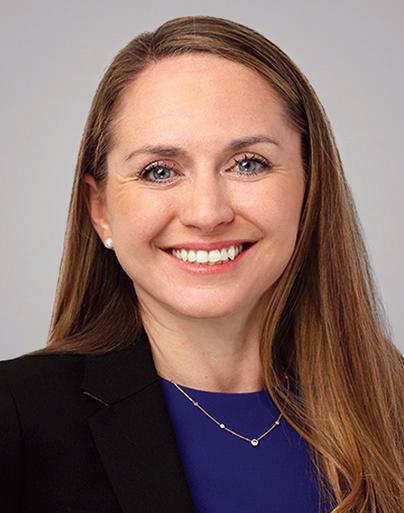
Origami Solar, the Bend, Ore.-based developer of sustainable and domestically produced steel solar module frames, has announced the appointment of Lauren Busby Ahsler, P.E., S.E., as vice president of engineering. Ahsler brings more than 15 years of experience leading mechanical and structural engineering teams and developing solar products. In her new role, she will head Origami Solar’s engineering and testing team, driving transformative innovations in extending the structural performance of Origami’s steel module frame technology to support future market needs.
Ahsler joins Origami Solar from Valmont Solar, where she served as director of structural engineering and oversaw the design, testing, and certification of Convert brand trackers. The company, founded in 2019, previously appointed Michael Gray as its CEO back in October.
The National Association of Electrical Distributors has named Wes Smith as its new president and CEO, the St. Louis-based organization announced in February. He previously worked as the senior advisor for Rexel USA and as president and CEO of Mayer prior to Mayer becoming part of Rexel. Smith has grown up in the industry, starting in the warehouse and working through various roles in finance, technology, continuous improvement, operations, and strategy.
“We wanted someone with a technology bent and an eye over the horizon,” John Cain, NAED board chairman, said. “We also wanted someone who knew the industry as a distributor but fully understood the importance of relationships with our manufacturer partners and other critical players in the industry.” — Charlie Barks EA
Don’t
The U.S. Post Office requires that we mail EA to active subscribers only. If it’s been a while since you’ve renewed your subscription, we need to hear from you now!

To renew by mail or fax, send us the mailing label on the front cover of this issue, along with a signed note saying that you want to continue to receive the magazine. Fax to 866-228-7274, or mail to:
Electrical Apparatus
Barks Publications, Inc. 17 N State St Ste 914 Chicago, IL 60602-3570 Or contact us at (312) 626-2316; barbara@barks.com
Lauren Ahsler
Nitin Kulkarni
ELECTRICAL APPARATUS | APRIL 2024 39
To renew online, go to http://earenew.com or log on with this QR code: be dropped!
Product Showcase
The newest and best in tools and equipment for the plant and shop
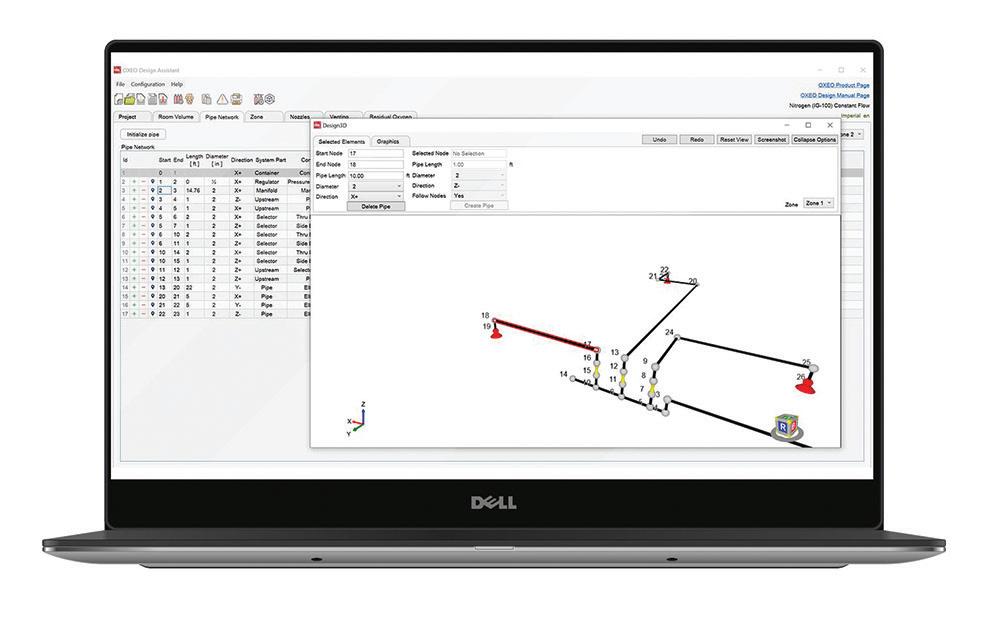

Fire protection with low environmental impact
Viking Group, Inc., a Michigan-based manufacturer and distributor of re protection products, has introduced its newest digital tool, vlnert, a design and calculation software program for the Oxeo Extinguishing System, a fire suppression system that uses inert gas to protect damage-sensitive applications without harmful environmental impacts or damage to complex equipment.
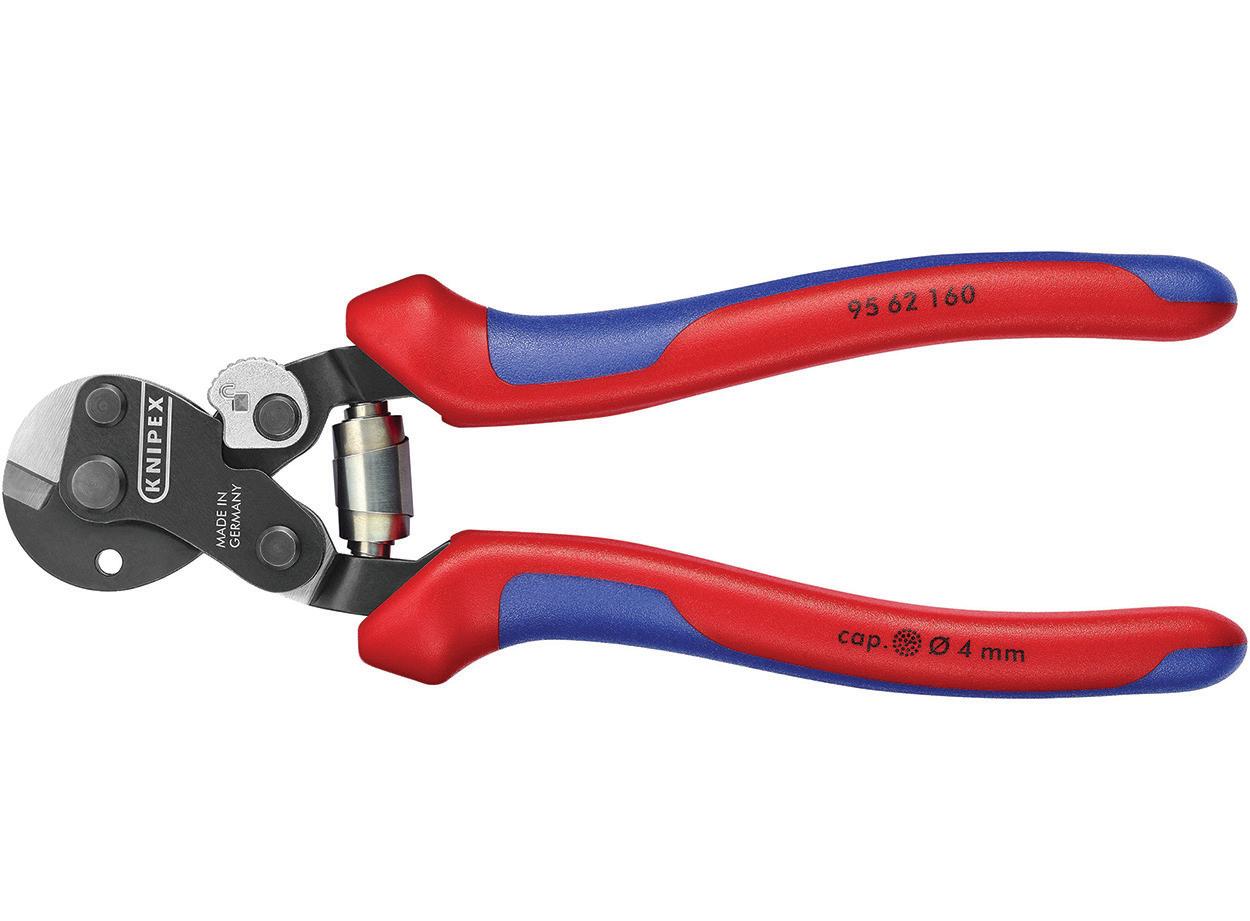

Knipex multi-component wire rope cutters
Released by Knipex, these new wire rope cutters with doublemounted box joint design provide a high level of stability for cutting 4 mm to 6 mm wire rope. Lightweight, compact, and made of ball bearing steel, this tool requires less physical e ort compared to others on the market, the German company says. The tool is induction-hardened, with cutting-edge hardness of approximately 64 HRC. It’s said to be suitable for precision cutting needs such as bicycle derailleur, brake cables, and more.


Electric actuators for a clean alternative
Thomson is providing a clean energy-e cient alternative for linear motion projects with its line of electric actuators. Unlike hydraulic cylinders, electric linear actuators embed all operating functionality in the actuator housing itself, which connects an electronic control unit with only a few 24 V and 12 V wires. Microprocessor-based printed circuit boards with complementary software allow communication between remote networks. Thomson electric actuators have enhanced control functions, integrated electronics, and environmental protection against harsh conditions, resulting in higher productivity and less maintenance, according to the company.


Upgraded home solar kits
Slenergy recently introduced an upgraded version of the single-window purchase solar kit, iShare-Home. The system now includes solar panels, a hybrid inverter, energy storage battery, mounting structure and cable set, along with a smart energy management system, heat pump, smart EV charger, and the innovative iBox, ensuring complete protection. A key feature of the upgraded iShare-Home system lies in its smart operation and maintenance, facilitated by the SmartBox. This IoT-intelligent hardware collects real-time operational data from other connected devices. The SmartBox executes intelligent control strategies to achieve intelligent centralized management, optimizing energy use and cost savings, according to Slenergy.
40 ELECTRICAL APPARATUS | APRIL 2024
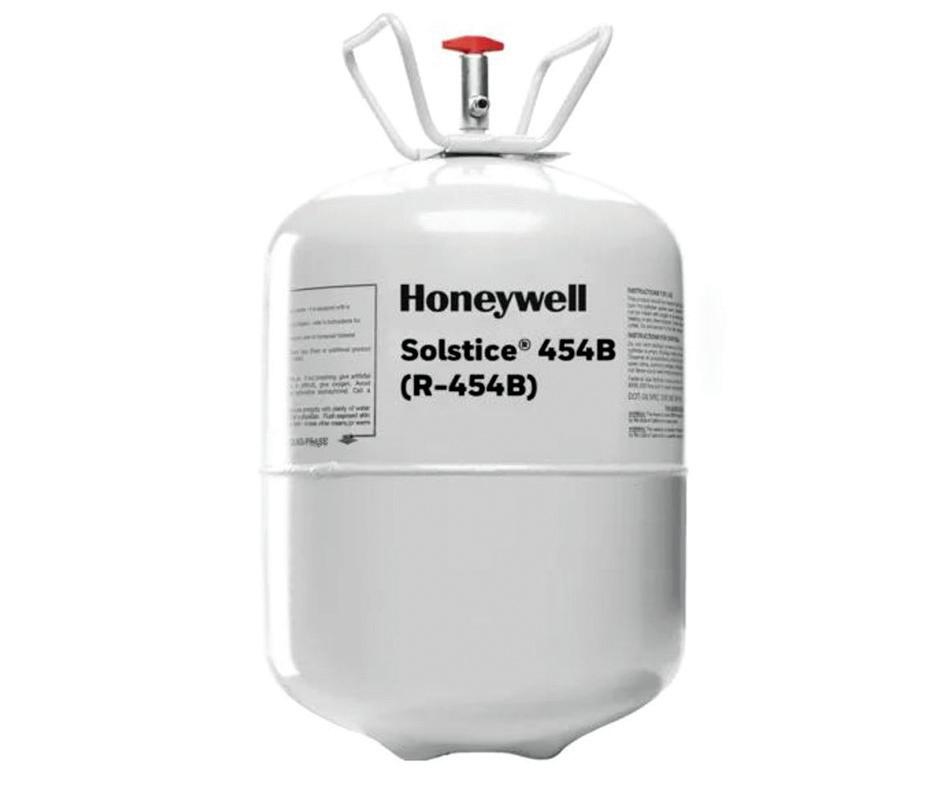

Refrigerant for use in residential AC
Solstice 454B, from Honeywell, is a non-ozone-depleting, zeotropic blend of refrigerant designed as a low GWP alternative to R-410A in reversible chillers and heat pumps. Hisense and Honeywell have partnered to integrate the Solstice 454B into all residential-related products in an e ort to provide more sustainability, e ciency, and a 78% lower GWP than the company’s previous iteration, R-410A, that enables OEMs to transition their R-410A equipment to a lower GWP alternative.


Food recycling system uses AI techniques
Mill Industries has released its latest version of a food waste recycling system that turns household food scraps into dry grounds to feed farms or gardens. The vertical stainless-steel augers are able to quietly and e ciently dry and grind food scraps overnight into clean, dry grounds. The bin can process up to 40 lbs. of wet food scraps before it needs to be emptied. It also includes a built-in odor system, including 2 million square meters of coconut charcoal, along with a quiet hum of 41 decibels, the two of which combine to keep a low pro le within the home. — Chelsea Fisher EA

ELECTRICAL APPARATUS | APRIL 2024 41
Eye in the sky
A satellite is intended to monitor and ‘call out’ the world’s worst polluters
By Charlie Barks, EA Managing Editor
On March 4, from Vandenberg Space Force Base in Lompoc, Calif., a controversial satellite labeled MethaneSAT lifted off aboard a SpaceX Falcon9 rocket with intentions some consider righteous, but many others are calling dubious.
The satellite’s stated design mission is “to help protect the Earth’s climate by accelerating reductions of a powerful greenhouse pollutant, focusing first on oil and gas operators, the world’s largest industrial source of methane emissions,” according to its developers.
Yikes. Oil and gas operators have long been a target of climate activists’ ire, but never before have they had to consider an all-seeing eye in the sky watching everything they do with the intention of relaying it to the public.
Seeing what others can’t
Developed by a subsidiary of the non-profit Environmental Defense Fund, MethaneSAT will see and quantify total methane emissions over wide areas that other satellites can’t detect and identify large emitters in places those satellites “aren’t looking,” EDF says. Data from MethaneSAT will enable both companies and regulators to track emissions and give stakeholders – citizens, governments, investors, and gas importers – free, nearly real-time access to
the data, and the unprecedented ability to compare the results against emission goals and obligations.
“Cutting methane pollution from fossil fuel operations, agriculture, and other sectors is the single fastest way to slow the rate of warming as we continue to decarbonize our energy systems,” said EDF president Fred Krupp, referring to reports of global temperatures.
EDF is an organization that has focused on pushing methane science and solutions for more than a decade, including organizing a series of 16 independent studies that it says showed methane emissions across the U.S. oil and gas supply chain were 60% higher than EPA estimates at the time. MethaneSAT is a direct outgrowth of these efforts.
Circling the Earth 15 times a day, MethaneSAT will measure changes in methane concentrations as small as three parts per billion. It plans to do this using a combination of high sensitivity, high resolution, and a wide field of view.
Putting science and data first
“Methane emissions have been overlooked and hard to detect for far too long,” said Dr. Kelly Levin, chief of science, data and systems change at the Bezos Earth Fund. “MethaneSAT changes the equation, putting science and data front and center. From the sky, it can see what others can’t, helping good actors and holding bad actors accountable. The Bezos Earth Fund is proud to be a partner in this adventure.”
In December, EDF joined with Bloomberg Philanthropies, the International Energy Agency, RMI, and the UN Environment Program’s International Methane Emission Observatory on a new, first-of-its-kind initiative intended “to hold companies and governments more accountable for their methane management.”

In addition to identifying emission sources and rates for a given region, MethaneSAT will make it possible to compare emission loss rates across major oil and gas regions worldwide and performance over time. Analytics developed especially for the mission will trace those emissions back to their sources within those target regions.
“We have consistently seen the power of strong data to win robust regulatory safeguards and better operating practices in the industry,” said Mark Brownstein, EDF senior vice president, Energy Transition. “Good science lays the groundwork for better decisions.”
EA
The MethaneSAT satellite under construction.
Feature | Energy 42 ELECTRICAL APPARATUS | APRIL 2024
— BAE Systems photo
Embracing rotational training
A pattern of promotion that can help an individual gain a ‘big picture’ understanding of a business
By Maura Keller, EA Contributing Writer
When new employees join a manufacturer, they often are eager to learn as much as they can about the roles and responsibilities of various functions within an organization. Not only does this help the employee develop a diverse skill set and be exposed to all facets of a company, but it allows the company to rotationally educate employees, benefiting the manufacturer during challenging times.
According to Deloitte’s analysis of Purchasing Managers’ Index data, the manufacturing sector was in contraction for most of 2023 and continues to face headwinds. In 2024, manufacturers are “expected to face economic uncertainty, the ongoing shortage of skilled labor, lingering and targeted supply chain disruptions, and new challenges spurred by the need for product innovation to meet company-set net-zero emissions goals.”
Deloitte further pointed out that in a recent survey conducted by the National Association of Manufacturers, almost three-quarters of surveyed manufacturing executives feel that attracting and retaining a quality workforce is their primary business challenge. Manufacturers have been proactive about adjusting their workforce policies to improve employee attraction and retention. One way of doing this is with rotational training.
Help in finding a niche
As the vice president of human resources and practice lead at Clarke Caniff Strategic Search, Kristen Fowler has onboarded and led hundreds of employees at her own firm, while also providing guidance to clients on their own HR best practices, including rotational training.
As Fowler explains, rotational management training is when you move an employee to a new position within the organization every six to 12 months over a two-to-three-year period. This practice has been used for the last few decades, often by larger organizations, to allow employees exposure to many facets of the business and management styles for more junior employees or new managers.
“Rotational management training programs can help expose an individual to many facets of the business, allowing them to get a more ‘big picture’ view of how the organization runs. These programs also allow an individual to get exposure to an area of a business they may not have had previous interest in and can help find their niche,” Fowler said. For example, a supply chain major may get exposed to a more productionoperational role they may not have previously considered enjoying.
According to Kristin Fowler, rotational management can improve employee engagement and provide a fresh set of eyes on a business

Employee engagement
From an employer’s perspective, rotational training can increase employee engagement by ensuring the employee is continuously learning something new and not feeling stagnant. It also allows for a fresh set of eyes on the business that can offer process improvements.
“Employees are likely to be more engaged as well, with their job responsibilities constantly shifting and allowing them to learn,” Fowler said. “In the long term, it also allows the employee to have a better understanding of the business as a whole and connect the dots between business segments.”
Rotational training programs are not without challenges. It can be difficult to manage and keep track of employee performance over the long term. Also, some rotations may not be long enough for participating employees to fully understand or make changes within a particular business segment.
Fowler stresses that companies should be clear about what they expect employees to learn or accomplish during each rotation. Allowance should be given for feedback from employees on how they hope to develop their careers for the long term. EA
Feature | Training & Education
Kristin Fowler, vice president of human resources and practice lead at Clarke Caniff Strategic Search, says that rotational management training can give employees more comprehensive understandings of their companies.
ELECTRICAL APPARATUS | APRIL 2024 43
Feds open the money spigot for water infrastructure spending
An unprecedented quantity of money is being unleashed for spending on U.S. water infrastructure — but there’s a catch
By Kevin Jones, EA Senior Editor
Pumps are just one of many components of U.S. drinking water and clean-water infrastructure that received a financial boost Feb. 20 when the White House announced the release of $5.8 billion for spending on U.S. water infrastructure. The funding is part of more than $50 billion in planned spending on water infrastructure resulting from the Bipartisan Infrastructure Law, and it’s said by the White House to be “the largest such investment in American history.” This federal largesse, however, comes with conditions.
The spending announced Feb. 20 is intended to support water infrastructure that protects public health and “treasured water bodies across the nation,” according to the White House statement. Almost half of the funding will be available as grants or principal forgiveness loans, the announcement said, “ensuring funds reach underserved communities most in need of investments in water infrastructure.”
The money is to be disbursed through the U.S. Environmental Protection Agency’s Clean Water State Revolving Fund, a bureau that for more than 30 years has overseen the distribution of federal funds to U.S. states and territories to aid in purifying and distributing the water we use for drinking, irrigation, and other purposes. It does so by providing low-cost financing to communities for a wide range of water quality projects. These include municipal wastewater facilities, nonpoint source pollution control, decentralized wastewater treatment systems, storm water runoff mitigation, green infrastructure, estuary protection, and water reuse.
Environmental infrastructure banks
Under the Clean Water State Revolving Fund, the 50 states, along with Puerto Rico, contribute an additional 20% to the federal grants. For these, the revolving funds function like “environmental infrastructure banks,” providing low-interest loans for water infrastructure projects.
“As money is paid back into the state’s revolving loan fund, the state makes new loans to other recipients for high-priority water quality activities,” the EPA explains. “Repayments of loan principal and interest earnings are recycled back into individual state CWSRF programs to finance new projects that allow the funds to ‘revolve’ at the state level over time.” The EPA also provides direct grants to qualifying projects in the District of Columbia, the U.S. Virgin Islands, American Samoa, Guam, and the Commonwealth of Northern Marianas.
While the federal government provides the bulk of the funding, each state is responsible for the administration of its own revolving fund, allowing for some flexibility in how the funds are distributed. States may provide various types of assistance, such as loans, refinancing, purchasing, or guaranteeing local debt and purchasing bond insurance.
States also set their own loan terms, including interest rates and repayment periods, which may extend up to 30 years.
States may also customize loans to give priority to “small and disadvantaged communities,” and they can incentivize certain types of projects deemed more important than others. Individual state revolving funds can give additional financial assistance through grants, principal forgiveness, and negative interest rate loans. They may also zero in on “green” infrastructure as well as improvements in water and energy efficiency.
A total of 11 types of projects are eligible to receive funding through these funds. Most of the projects involve pumps and pumping systems. They include construction of publicly owned treatment plants, pollution-management systems, storm water management, water conservation and reuse, and watershed projects.
For example, a centralized wastewater treatment project might qualify for an upgrade, repair, or replacement of pump stations along with related elements such as pipes, force mains, screening systems, grit chambers, clarifiers, and storm sewers. The purchase of portable pumps might be justified for use in “climate resilience” for treatment works.
As of Feb. 16 of this year, some $11.7 billion of the $50 billion had been handed out. The state receiving the most money to date has been California, whose $248 million constitutes 10.8% of funds that have been made available to states so far. Texas, for which 8% has been earmarked, came in second, while New York State, with 4.67%, was third. Florida, with a greater population than New York State, has received 3.61%.
Replacing pipes and water mains
As an example of how this works in practice, the White House in its February announcement pointed to a case in Pittsburgh where water utilities have been removing lead service lines from operation to reduce exposure to lead from drinking water. The city’s Wilkinsburg-Penn Joint Water Authority used
Feature | Pump It Up 44 ELECTRICAL APPARATUS | APRIL 2024
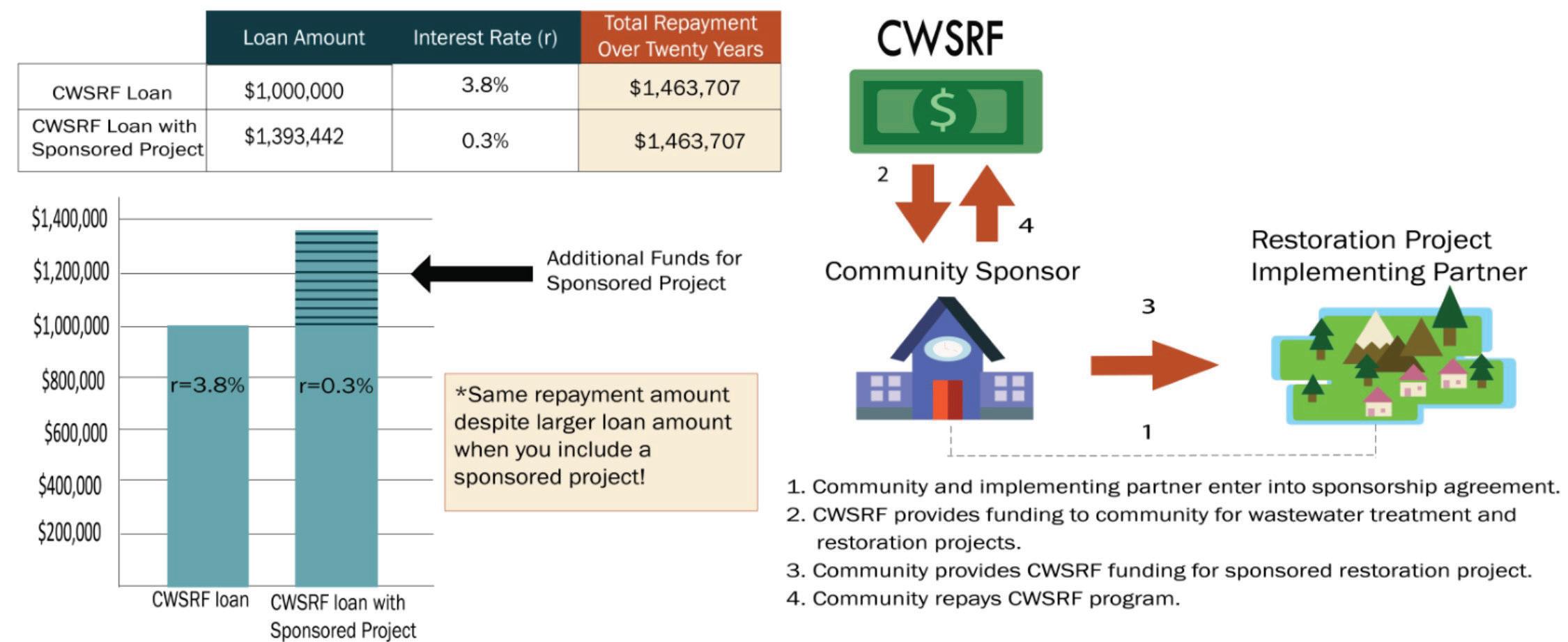
$9.5 million from the State Revolving Fund during fiscal year 2023 to replace about 1,000 lead service lines in low-income residential neighborhoods. Elsewhere in Pennsylvania, in Bucks, Schuykill, and Lawrence Counties, roughly $14 million was designated by the EPA for such things as pipes and sewer mains.
In California, the state so far receiving the most funding, the Office of Sustainable Water Solutions processes applications for grants and principal forgiveness. Applications are accepted online through something called the Financial Assistance Application Submittal Tool, on a website where applicants can also find how-to videos that will walk them through creating accounts and starting and submitting funding applications.
Those seeking funding for drinking water and wastewater construction projects in California are directed to the Small Community Funding Program, where they can learn about the pre-application process, initial eligibility screening, and planning and construction applications. According to California’s Office of Sustainable Water Solutions, its interest rate is half of the most recent General Obligation Bond rate.
Taking another state at random, Tennessee offers online resources similar to those offered by California. In addition to providing a rough outline of how the Clean Water State Revolving Fund works, Tennessee’s Dept. of Environment & Conservation offers the familiar digital tools along with annual Clean Water Priority Ranking Lists, with this note: “Only those proposed projects identified on the SRF Priority Ranking List are eligible to receive financial assistance for the planning, design, and construc-
tion of wastewater and storm water facilities.” At the top of the 2022 priority list was a project in Fayette County, Tenn., for the renovation and expansion of a wastewater treatment plant in the town of Oakland; among the items covered were new effluent pumps.
And now, the catch . . .
All of these billions of dollars come with conditions. The federal grants and loans being administered through the Clean Water State Revolving Fund are subject to restrictions under the Build America, Buy America Act, a law enacted in November 2021 as part of the Infrastructure Investment and Jobs Act. The Buy America Act requires that “none of the funds made available for a Federal financial assistance program for infrastructure, including each deficient program, may be obligated for a project unless all of the iron, steel, manufactured products, and construction materials used in the project are produced in the United States.”
The EPA issued a memorandum in November 2022 explaining in detail what these restrictions apply to. “The manufactured products category would cover the majority of potential water infrastructure products, including complex products made up of a variety of material types and components,” the memorandum states. “For water infrastructure projects, common manufactured products would include, but not be limited to, pumps [emphasis added], motors, blowers, aerators, generators, instrumentation and control systems, gauges, meters, measurement equipment, treatment equipment, dewatering equipment, actuators, and many other mechanical and electrical items.”
Exceptions to these restrictions might apply. An “adjustment period waiver” grants relief on projects for which planning began prior to May 14, 2022. For these, “non-domestic manufactured products and nonferrous construction materials” may be used. The EPA is also leaving the door open to possibly lifting its restrictions, at least temporarily, on certain imported products and materials, depending on supply-chain considerations.
No one ever said spending federal money was simple. EA
ELECTRICAL APPARATUS | APRIL 2024 45
The U.S. Environmental Protection Agency’s Clean Water State Revolving Fund, working in conjunction with state agencies, provides what it calls “sponsorship lending” to address a lack of revenue stream common to many wastewater treatment system improvements. This diagram shows how low-interest loans combined with community funding can boost funding for projects spread over 20 years. — EPA diagram
New handbook explains wholesale energy markets
Anyone approaching the wholesale U.S. energy market for the rst time could be forgiven for becoming hopelessly confused. The routes by which natural gas and electricity make their way from source to consumer are Byzantine paths of free-market and managed economies, vertical and horizontal markets, cooperating competitors, non-pro t and for-pro t entities, shortterm and long-term demand forecasts, regulatory jurisdictions with di ering requirements, and “regulated monopolies.”
Fortunately, an agency of the federal government has issued a handbook, now available as a PDF at no charge, that lays it all out in plain English. The 2024 Energy Primer: A Handbook of Energy Market Basics was released this past January by the Federal Energy Regulatory Commission, an independent agency of the U.S. government that regulates the interstate transmission and wholesale sale of electricity and natural gas. (You can nd and download the handbook by going to www. ferc.gov and searching for “FERC Sta issues 2024 Energy Primer: A Handbook of Energy Market Basics.”)
Much of the rst part of the handbook is devoted to wholesale natural gas markets — a subject that people interested primarily in electricity markets cannot afford to ignore. Natural gas is the largest source of electricity generated in the U.S., and in 2021, the electric power sector accounted for about 37% of total U.S. natural gas use.
Electricity markets, the handbook explains, encompass both retail and wholesale components. On the retail side, electricity is sold directly to consumers, whether residential, commercial, or industrial. Wholesale markets, on the other hand, involve the sale of electricity among electric utilities and traders before it reaches consumers. The Federal Energy Regulatory Commission oversees wholesale electric rates because these rates involve interstate commerce, while retail rates typically fall under the jurisdiction of individual states.
Wholesale electric markets typically rely on competitive pricing, but some rates are based on the service provider’s cost of service — a curious situation in which free-market and managed electricity economies sometimes exist in adjacent service areas. These rates are in uenced by such physical fundamentals as weather conditions, fuel costs, capital expenses, transmission capacity, and power plant characteristics. The actual price of electricity results from the familiar interplay between supply and demand.
We learn from the handbook that there were several phases that helped shape today’s U.S. wholesale electricity market as we know it today:
Regulated monopolies. In the early years of U.S. electrication, monopolies ruled. Over time, utilities became regulated, typically by state agencies, out of concern not only for prices being paid by consumers but also for the stability of a capital-intensive industry. Many utilities were granted exclusive service territories, or franchises, that became subject to government oversight. Many of these utilities then began issuing stock,




transforming them into investor-owned utilities. Electricity rates today are based largely on cost of service, while wholesale pricing has become increasingly market-based.
Not-for-pro t utilities. The earliest electri cation in the U.S. was provided by municipal power agencies. As demand for electric service expanded into the hinterlands, the federal government stepped in to develop and distribute electricity generated by hydroelectric resources. The Great Depression saw the further expansion of rural electri cation programs promoting customer-owned rural electric cooperatives.
Power pools. Even monopolists sometimes need to cooperate with one another. Power pools, the handbook informs us, “are multilateral arrangements with members ceding operational control over their generating units and transmission facilities to a common operator.” The rst such pool was PJM, which began in 1927 for utilities to share their generating resources.
Competitive generation and open access. In the 1970s, environmental policy and initiatives to open the airline and trucking industries to competition helped shape the future of the electric utility industry. An energy plan introduced during the Carter administration led to passage of the Public Utility Regulatory Policies Act of 1978, which encouraged the use of e cient cogeneration and small-scale renewable generation. This resulted in an unexpected overabundance of qualifying facilities, which inspired many policy makers and entrepreneurs to consider the viability of generation independent of regulated monopolies. These and other approaches to open access resulted in the patchwork of transmission access we have today.
Independent system operators and regional transmission organizations. Beginning in 2006, the Federal Energy Regulatory Commission issued a series of orders aimed at removing “impediments to competition in the wholesale bulk power marketplace and to bring more e cient, lower-cost power to the nation’s electricity consumers.” This led to the creation of independent system operators, or ISOs — non-pro t entities that ensure the reliable transmission of electricity across the grid. Then, in 2000, the Commission issued an order to establish regional transmission organizations, or RTOs, with the goal of promoting e ciency in wholesale electricity markets “and to ensure that electricity consumers pay the lowest price possible for reliable service.”
There’s much more to the structure of the wholesale electric utility market than this. What the handbook makes clear is that the interested parties have constantly been guided by a desire to ensure reasonable prices for consumers while maintaining a pro t motive for private players to develop ever-better power transmission systems.
—
Kevin Jones EA
Utilities
The wholesale electricity market in the U.S. has evolved into ten regions consisting of independent system operators, regional transmission organizations, and power pools. Each enjoys some measure of autonomy but is subject to oversight by the Federal Energy Regulatory Commission.
46 ELECTRICAL APPARATUS | APRIL 2024
— Federal Energy Regulatory Commission graphic
Plant Happenings
A tangled web

Sheridan Wisconsin, the Madison printing plant formerly known as Webcrafters, is closing its doors after more than 150 years, with the expected elimination of more than 100 jobs. The closure “has been prompted by the company’s significant downturn in business at the Madison location,” parent company CJK Group said in a letter to the state’s Dept. of Workforce Development. A spokesperson for Sheridan Wisconsin, which manufactures books used in education and to be sold in bookstores, said orders have declined as schools and universities “shift to digital” and retail book publishers outsource their business overseas.
Shoals flexes muscle
and is expected to create at least 15 new jobs and retain 117 existing ones. U.S. Boiler Co. has been headquartered in Lancaster since its founding in 1992. The project expansion will cost about $5.5 million.
U.S. Boiler Co. received a funding proposal from the Dept. of Community and Economic Development for a $3 million Pennsylvania Industrial Development Authority loan, a $177,000 Pennsylvania First grant, and a $45,000 workforce development grant to train workers.
“Manufacturing remains the leading sector of Lancaster County’s economy, contributing 17.2% of our GDP and 16.7% of our total employment,” said John Biemiller, director of business retention and expansion for the Economic Development Company of Lancaster County. “This investment by U.S. Boiler Co. strengthens their local operations and further builds the industrial base in this community.”
The Maine event
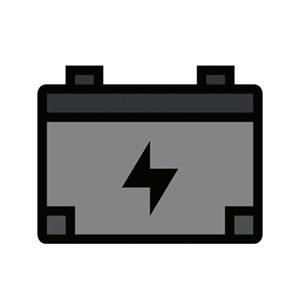
Tennessee Gov. Bill Lee, Dept. of Economic and Community Development Commissioner Stuart C. McWhorter, and Shoals Technologies Group officials say the company will invest $80 million over the next five years to expand its existing manufacturing and distribution operations to a new, larger location in Portland, Tenn. Shoals will create approximately 550 new jobs over the next five years in Sumner County, bringing the company’s total headcount in the region to roughly 1,400, according to a Feb. 21 statement. As part of the expansion, Shoals will relocate its manufacturing operations to a 638,000-square-foot plant at 1500 Shoals Way. The additional staff and larger facility will enable Shoals to better meet its growing customer demand for solar power.
Founded in 1996 and headquartered in Portland, Tenn., Shoals Technologies Group is an electrical balance of systems provider for solar, energy storage, and e-mobility. Those interested in careers at Shoals can contact recruiting@shoals.com or visit Careers at Shoals Technologies Group: Global EBoS Products. Since 2020, TNECD has supported nearly 10 economic development projects in Sumner County, resulting in approximately 1,000 job commitments and $1 billion in capital investment.
Boilerplate

Backed by a state investment of over $3.2 million, residential and light commercial heating product manufacturer U.S. Boiler Co. is constructing a new 45,000-square-foot manufacturing facility in Lancaster, Pa., that will house production lines, conveyors, and storage racking, according to a statement from the office of Pennsylvania Gov. Josh Shapiro. The expansion will allow the company to increase production of its most popular family of low-emission, high-efficiency boilers, Alta,
Local developers in Limestone, Me., have reportedly chosen the former Loring Air Force Base as the site of a $55 million potato chip processing plant that could open as soon as 2025, according to the Bangor Daily News. Falcon Transportation of Presque Isle, Me., announced in February that it plans to locate Taste of Maine Potato Chip Co. at Loring Commerce Center, a 3,800-acre industrial and commercial park that opened after the base closed in 1994. The state awaits further information on the proposed site.
Casing point

Alabama Gov. Kay Ivey announced Feb. 15 that Conecuh Sausage, an iconic Alabama maker of hickory smoked sausages, plans to invest nearly $58 million to open a second production facility in the state, creating 110 jobs in Andalusia. Conecuh Sausage was founded in Evergreen in 1947, and the production location in Conecuh County will remain operational as the company expands to meet increasing demand for its products.

“Conecuh Sausage is a landmark homegrown brand, and I am thrilled to see that the company continues to grow and thrive right here in ‘Sweet Home Alabama,’” said Governor Ivey. “This growth project will allow Conecuh Sausage to extend the reach of its brand and put its distinctive Alabama flavors in even more kitchens.” As part of the project, the company has committed to creating at least 110 new jobs in Andalusia and to investing $57.8 million to construct and equip the new facility in Covington County, according to the Alabama Dept. of Commerce.
Panel decision

Toledo, Ohio-based Decorative Panels International is shutting down its Alpena, Mich., facility, according to a statement from the company issued Feb. 23. The layoff and upcoming closure of the plant will impact more than 150 employees. Certain segments of the business will halt operations immediately, while others are scheduled to wind down later in the year. Key leaders and essential personnel will remain with the company to oversee the closure.
—
Charlie Barks EA
ELECTRICAL APPARATUS | APRIL 2024 47
Classified
RATES AND INFORMATION
Regular classified ads - straight lineage with optional logo: Per 8 pt. line (1 column width): $14. (Blank lines for spacing also charged.) Minimum charge: $70. $7 confidential box number system. B/w or color logos and limited formatting may be added for additional charges. Available categories: Business for Sale; Equipment for Sale, Equipment Wanted; Help Wanted; Position Wanted; Training.
Classified Display adsadvertiser’s own art with no category limitations*:
$200 per column inch; minimum 12 inches in 12 months. Maximum ad size in one issue, 3 inches. Add color for all ads in contract period $600.
For more information, closing dates and requirements, contact Barbara Wachter, Advertising Director E-mail: barbara@barks. com Phone: (312) 626-2316
*subject to Publisher’s acceptance
Cy’sSuperService
Business for Sale
BUSINESS FOR SALE
PRICE REDUCED
Business and building on 1 acre. Full service electric motor rewind, sales and repair facility in south central Colorado. Established 50 plus years. Over 4,000 vertical irrigation pumps, averaging over 30 horsepower, alone. Great location for hunting, fishing and skiing. Owner would like to semi-retire and is willing to help new owner.
Email anc.electricmotorrepair@yahoo.com
Help Wanted

EASA SEEKS MOTOR ENGINEER
Join EASA’s world-renowned technical support team! EASA seeks an engineer with at least 5 years of experience in repair, service, maintenance and/or redesign of ac and dc motors. Must understand motor theory as well as application and be able to communicate effectively in a fast-paced consulting role. Some travel required. For more info, see easa.com/careers.
Competitive salary; excellent benefits; team environment. Remote work option for the right candidate.
This is an exciting role with variety that impacts the entire indsutry. Send cover note and resumé to Linda Raynes; lraynes@easa.com.
Business for Sale
FOR SALE
Small electrical repair shop also has motor rewinding capabilities. Ukiah, California. Only game in two counties. Price right. 707.463.1800, 707.489.2327. marel920@sbcglobal.net Owner lives in town if help is needed.
Help Wanted

MULTIPLE JOB OPENINGS
Romanoff Industries is looking for qualified candidates to work with us in Toledo, Ohio in the following roles:
• Shop Manager
• Electric Motor Mechanic
• Shop Help and Motor Prep
• Vehicle and Property Maintenance Technician
Romanoff Industries has been in business for 43 years and is continuing to thrive and grow with our national customer base. Reasonable cost of living in Toledo, competitive pay, and room for growth within the company make working here a great opportunity. Relocation assistance may be provided for the right candidates.
Please contact Dan Cavese at 419-691-2888 or dcavese@romanoffindustries.com for further info or to submit a resume.
COPYRIGHT 2024 ELECTRICAL APPARATUS

48 ELECTRICAL APPARATUS | APRIL 2024



CURRENT OPENINGS
priestelectric.com
•Experienced Winder
3PH, 1PH, Form coil up through medium voltage.
•Experienced Manual Machinist Lathe set-up/operation, drill press, milling machine, maintenance and upkeep.
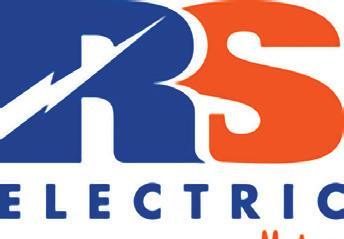
SIGN ON BONUS!
R/S Motors, a St Joseph, MO based company, has an immediate opening for a mechanic/ machinist/winder. Both AC & DC motors. Experience preferred but can support on the job training. O ering competitive wages, 100% company paid health, 401K, PTO-2 weeks vacation the first year. Relocation allowance. Friendly hours. Family owned company with a great environment and people. Please submit any inquiries or résumés to info@rselectricmotors.com.



•Experienced Motor Mechanic AC/DC testing, troubleshooting, pumps/ seals, gear reducers, field service.
Competitive wages DOE, vacation & sick time, 401k, health insurance, paid holidays, relocation assistance.
Inquiries and Resume to:
electricmotorjobs@gmail.com



The EA word search
Under the sea
In the grid at left, nd and circle the words listed below, taken from this month’s “EA Reader Pro le” of Rodney Fuller. The uncircled letters, arranged in order, will spell out a crucial component of the Tennessee Aquarium.
The solution may be found online at http://barks.com/puzzles, or call (312)321-9440. Happy hunting!
ELECTRICAL APPARATUS | APRIL 2024 49
About Architect Assembling Baptist Capital CMMS Daisy Electrician Engine Facilities
One Safety Self-taught Show Work DENIGNEAQUA ASSEMBLINGF IEHNTTENECA SLIOUCCLIRC YFFOWTTECSI TTBUOSRHAPL EAPSRIIOPRI FUTMKTCCIOT AGNMEPITTRI SHOCLAASAYE STTTEBNMLSS
NECA
Help Wanted Classified Display
Help Wanted
Help Wanted

NASHVILLE, TN
MULTIPLE JOB OPENINGS
IM&E is looking for qualified applicants to join our team. We are a leading provider in the Southeast for electric motor, pump and gearbox repair. We have openings for Winders, Mechanics, Machinists, Field Service and Servo Motor Repair. Competitive pay, relocation expenses, full time benefits, advancement, and overtime opportunities available! Email your resume to crobinson@ime-corp.com.
Visit us at www.ime-corp.com
Help Wanted

COMPETITIVE PAY, BENEFITS & OT!!
Prime Electric in Gorham, ME is looking for an experienced Electric Motor Technician. Relocation compensation, training program & advancement opportunities. Safe, friendly environment. Call 207-591-7800 or email résumés to dan@PrimeElectricMotor.com. Visit us at PrimeElectricMotor.com.

KELLER ELECTRICAL
in beautiful Arizona needs to add to our talented sta .
We are in need of AC/DC Motor Mechanics, Winders, Manual/CNC Machinists, Welders and Millwrights.
Relocation assistance may be provided for the right candidates.
We are an EOE and are able to o er competitive benefit packages along with attractive PTO.
If interested please email your current résumés to:
rob.rayl@otcindustrial.com
adam.geron@otcindustrial.com brad.blackwell@otcindustrial.com



ELECTRIC MOTOR WINDER
Best Repair Company in Norfolk VA is looking for qualified candidates for:
•Quality Manager
•Motor Winders
•Pump Mechanics
•Manual Machinist
•Shop Helpers
BRC o ers a competitive salary, health insurance & 401K plan. Visit our Web Site at www.Bestrepair.net or contact gary.phelps@bestrepair.net if interested.
Help Wanted

MOTOR REWINDER
Must have experience with single and three phase.
We o er competitive wages and benefit package.
Send resume to: steve@conrey.net or call 503-232-9392
DIGITAL COPIES!
Bookmark these links to access digital flipbooks
APRIL (this issue)
https://bit.ly/APR24WIND
MAY
https://bit.ly/MAY24LONG
JUNE
bit.ly/JUN24SALE
Help Wanted
THE STUTTERING FOUNDATION A Nonprofit Organization Since 1947—Helping Those Who Stutter ® StutteringHelp.org 800-992-9392 Getting words out is hard. We can help. art by nino ilievski
50 ELECTRICAL APPARATUS | APRIL 2024
Keep EA coming! Start or renew your subscription at http://ea-renew.com
Help Wanted
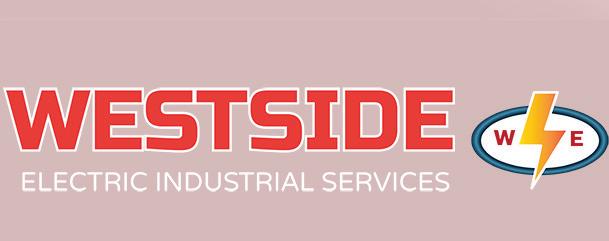
SHOP FOREMAN
Westside Electric Inc
Located in Jacksonville Florida
Experience in all areas of electric motors, AC & DC, generators, pumps. These repairs are found in a typical EASA repair facility. Must have good management and coordinating skills to advise and assist technicians in completing the jobs in a timely and accurate manner that will satisfy the customer and be profitable. The Foreman is responsible for scheduling shop work and field service and insuring that the customer’s needs are met. Safety procedures, customer relations and the knowledge of test equipment are required. Send résumé to bruce@westsideelectric.com or call (904)757-1126.


Electric Motor Shop in Wake Forest, NC, is looking for candidates for:
•Field Service Techs
•Manual Machinists
•Motor Mechanics
•Outside Sales Reps
•Field Service Manager
•Pump Mechanics
•Switchgear Specialist
•Winders
Electric Motor Shop o ers competitive pay and benefits, including 401k. For employment consideration, please contact Kristine Larsen at 919-556-3229 or by email at Kristine.Larsen@emsnc.com





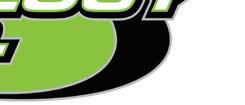
ELECTRIC MOTOR TECHNICIAN
- 2ND SHIFT
10+ years exp w. industrial AC/DC electric motors, generators & electro-mechanical equipment repair. Must have previous supervisory exp. Pay based on exp. + 12% shift di erential + supervisor pay. Excellent benefit package: 401k, medical, dental, vision, vacation, sick pay, paid holidays.
Apply at bit.ly/mti_jobs
Motor Technology, Inc.
515 Willow Springs Lane York, PA 17404
















Moe,Genny&Friends COPYRIGHT 2024 ELECTRICAL APPARATUS LED Stroboscope ESL-200 Standard LED ESL-200UV Ultraviolet LED ● Up to 150,000 fpm/rpm ● Rugged metal housing ● x2 and ÷2 buttons ● Phase shift ● Store 9 flash rates in memory UV Model Available! 866-527-4666 www.hoto-instruments.com Makes cycling objects appear stationary for inspection and measurement Classified Display Classified Display Classified Display Help Wanted
Help Wanted ELECTRICAL APPARATUS | APRIL 2024 51
SUPERVISOR
EEO
Help Wanted
Learn more about the products and services featured in this issue!
the QR code or go to https://shout.com/s/YqSjysfR to request information from advertisers.
Direct & Current
UNDER CONTROL. French energy giant Schneider Electric was able to offer some helpful reassurance and provide a framework for how to contain a hacking incident after it got hit with a malicious attempt in late January. Schneider confirmed that the incident was limited to its Sustainability Business division and had no impact on any other Schneider Electric entity. The company also confirmed that it was able to reopen business platforms within mere hours of the attack, an impressive feat.
PRETTY FLY. The MHIRJ Aviation Group, a maintenance, repair, and overhaul services provider to airline fleets globally, is planning to expand its workforce at Tucson International Airport by adding 100 jobs this year and more than 250 over the course of three years. The company intends to increase its capacity to meet customer demand for the maintenance and operational support of the CRJ and other products by activating additional maintenance lines.

BAD APPLE? The latest chapter in the electric car saga: Apple has reportedly canceled — or at least delayed until 2028 — its ambitions to create its own brand-name electric vehicle, according to multiple reports in early March. Apple has declined to comment, but if that’s the case, it would mean additional layoffs for that work team of the tech company, adding to the 150+ layoffs from that same group that occurred in 2019.
KELE GREEN. In a move poised to increase profitability, Memphis-based Kele, Inc., announced its acquisition of AC Controls and AC Technical Services. AC is a distributor and rep of industrial process and combustion applications. The acquisition “continues to expand Kele’s footprint within the industrial automation market,” the company noted, adding that “ACC will become an integral part of the industrial offerings of The Kele companies, which include Lesman Instrument Company [of Bensenville, Ill.) and A-tech Inc. [of Tulsa].”
WATCH AND LEARN. Ahead of the annual convention of the Electrical Apparatus Service Association, which is coming up in late June, the organization recently launched the Online Learning Center, an online platform offering a wide range of industry-specific training. Also new in the Online Learning Center is the Electromechanical Repair Technician Certificate Program. This program provides new, existing, and potential employees in the electromechanical repair industry with a structured learning path to become a well-rounded service center technician. — Charlie Barks
Have the digital “Direct & Current” delivered each week, at no charge, to your e-mail in-box. Scan the code at right or sign up now at http://eepurl.com/dEkrB9.
APRIL 2024
MHIRJ Aviation Group plans to expand its workforce. — MHIRJ photo
ADVERTISING INDEX Advanced Rotors, Inc. . . . . . . . 15 AKARD COMMUTATOR OF TENNESSEE . . . . . . . . . . . 9 BAE Wire & Insulation, Inc. . . . . . 51 Bartlett Bearing Company, Inc. 11 CWIEME Berlin . . . . . . . . . . . . 21 Electrical Apparatus & Machine 41 Electrical Apparatus Service Association 22 Electrom Instruments, Inc. 7 Hannover Trade Fair . . . . . . . . 23 HD Hyundai Electric America Corp. . . . . . . . . . . . . 5 Helwig Carbon Products, Inc. . . . 10 Hoto Instruments 51 Jasper Electric Motors, Inc. . . . . 17 Lafert North America . . . . . . . .IFC Mitchell Electronics, Inc. 8 Mod-Tronic Instruments Limited . . 14 OTS Wire & Insulation, Inc. 51 Overly Hautz 16 Pittsburgh Electrical Insulation. . . 13 PJ Electronics 39 Spring Point Solutions 6 Toshiba International Corporation . 3 Vaughen’s Price Publishing, Inc. 49 Von Roll USA 19 WEG Electric Corp. . . . . . . . . . BC WorldWide Electric Corporation IBC 52 ELECTRICAL APPARATUS | APRIL 2024
Use




-
-
-
-
-Marine-Duty
-Severe
-Stainless
-
-Motor






Motor Controls -Variable Frequency Drives -Soft Starters -Across the Line Starters - Pre-configured/Customizable Cabinets and Panels - Remote Operation, Pilot Devices, Safety Switches, Contactors & Relays Gear Reducers - Shaft Mount Reducers - Worm Gear Reducers
Helical Bevel Gear Reducers
Helical Inline Gear Reducers -Parallel Shaft Helical Gear Reducers
Accessories and Kits Discover More Capabilities with Worldwide Electric’s Family of Brands Industrial Products Proven Quality. Designed for demanding applications at affordable and competitive prices. Electric Motors
DC Motors
-
-
-
-
Explosion Proof Motors
Farm Duty Motors
General Purpose Motors
Metric Motors
- IEC
Motors
Proof Motors
- Open Drip
Motors
- Pump
Duty Motors
Steel Motors
Hollow Shaft Motors
Vertical
Accessories Generators
Single Bearing
-
Double Bearing -Pancake Call WorldWide (800) 808-2131 worldwideelectric.com





































































































































































































 The Exro Technologies U.S. headquarters in Mesa, Ariz.
The Exro Technologies U.S. headquarters in Mesa, Ariz.







 EASA pump and vibration specialist Gene Vogel gives a presentation at the association’s annual convention last year in National Harbor, Md. Four years previously, at the convention in St. Louis, he had described the promise that artificial intelligence holds for rotating machine maintenance. EASA and other associations have since continued to offer guidance on how to make the promise of AI a reality.
EASA pump and vibration specialist Gene Vogel gives a presentation at the association’s annual convention last year in National Harbor, Md. Four years previously, at the convention in St. Louis, he had described the promise that artificial intelligence holds for rotating machine maintenance. EASA and other associations have since continued to offer guidance on how to make the promise of AI a reality.










































































































































































































































